Welcome to the June 2024 issue of













Make quick, precise audio adjustments from anywhere, any time. Complement your news automation system with this virtual mixer.
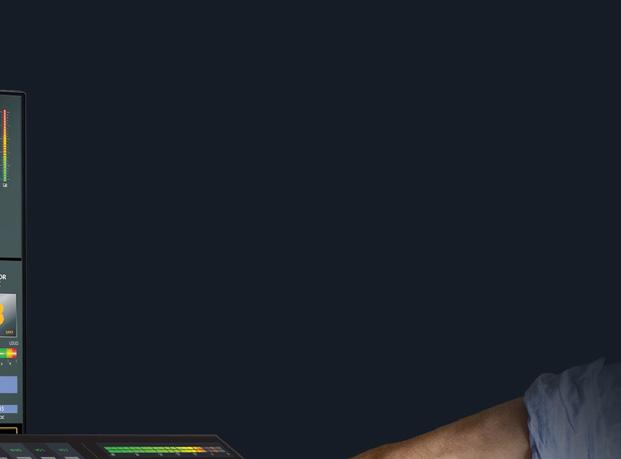






Adjust the occasional audio level with the Virtual Strata mixer as an extension of your production automation system. Mix feeds and manage the entire audio production with all the mix-minus, automixing, control and routing features you need from your touchscreen monitor or tablet. Fits in any broadcast environment as an AES67/SMPTE 2110 compatible, WheatNet-IP audio networked mixer console surface
Connect with your Wheatstone Sales Engineer Call +1 252-638-7000 or email sales@wheatstone.com


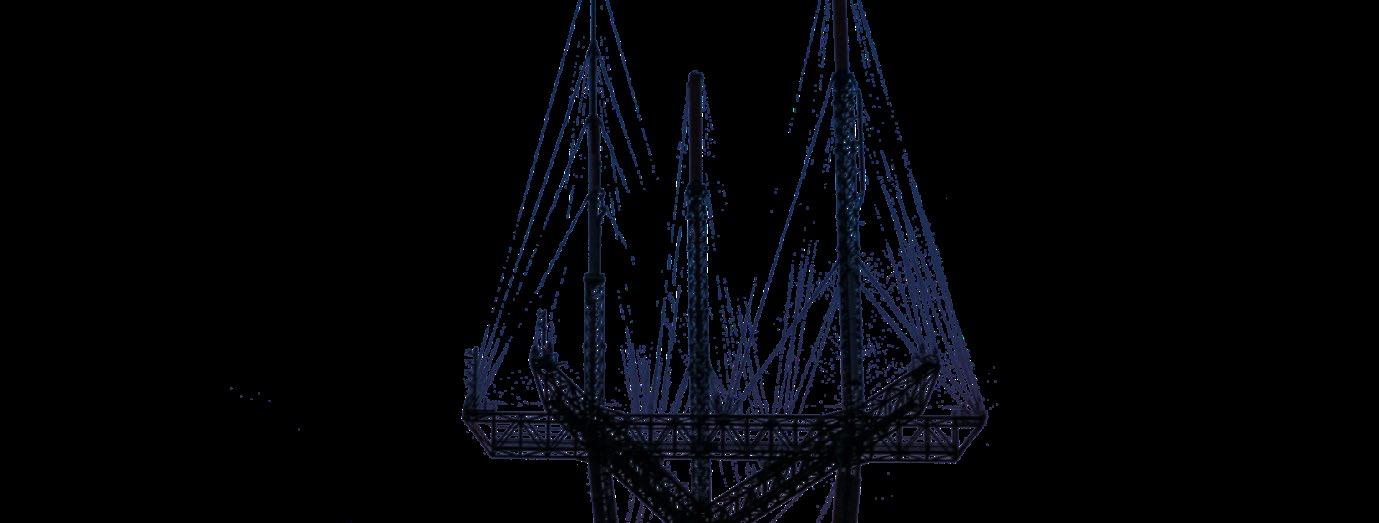











As the 2024 political campaign season gains steam, concerns over the impact of AI and social media’s continued threats to privacy have also emerged. Misinformation has always been a part of electoral politics but this year, those threats have been ramped up as more and more consumers get their news and information from a variety of sources, not all reputable.
That’s why a recent survey from Pew Research is so troubling. The survey noted a declining preference for local TV as a preferred source of news, declining usage of news from local TV stations and extensive dissatisfaction with the way all local news outlets cover such issues as the economy, local governments, schools and crime.
The “Americans’ Changing Relationship With Local News” study found that only 32% of those surveyed named TV as their preferred source of local news in 2024. While that is higher than any other media, it marks a significant decline from 2018, when 41% named local TV as their preferred source.

Approximately 26% of consumers named websites/apps as their preferred source, up from 23% in 2018 and social media was named by 23%, up from 15% in 2018. The study found that about 64% of Americans said they sometimes or often get information from local TV stations in 2024, down from 70% in 2018. Of those that got their news from local TV, 62% accessed it on TV, 20% from the station’s website or email and 18% from social media posts.
A large majority—85%—said local news is extremely important, important or somewhat important. Nevertheless, where they’re getting that news is also vital. Congress recently voted to ban TikTok amid concerns over users’ privacy and the potential harm from a foreign government using it to spread disinformation. Add AI to the mix and you have an existential threat to how voters get their news and information.
That’s why local TV (and radio) stations will play an even more important role this year in preventing disinformation from impacting local political campaigns and why Congress needs to pass the Journalism Competition and Preservation Act. The Act would put in place measures that would protect local broadcasters from having their data and information distorted, which in turn distorts their reputation. In addition, the act would provide broadcasters fair compensation when their data is used to train AI models.
Local broadcasters are among the most trusted sources of local news and information and as print continues to decline, putting such measures as the Journalism Competition and Preservation Act into place will help maintain support and confidence in local broadcasting.
Tom Butts Content Director tom.butts@futurenet.com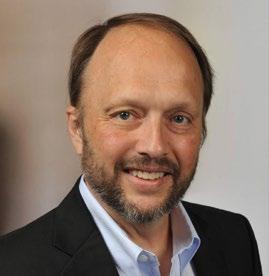
AI is the hottest topic to hit our industry since the cloud and while no one can predict its impact, we at TV Tech plan to report the latest news and analysis of this growing trend. In this issue, we welcome back John Footen who is penning our newest column on AI, “Media Matrix.” John Footen is a managing director who leads Deloitte Consulting LLP’s media technology and operations practice and the impact of AI on media is among his specialties. Welcome John! You can find his column on p. 19.
Vol. 42 No. 6 | June 2024
FOLLOW US www.tvtech.com twitter.com/tvtechnology
CONTENT
Content Director
Tom Butts, tom.butts@futurenet.com
Content Manager
Terry Scutt, terry.scutt@futurenet.com
Senior Content Producer George Winslow, george.winslow@futurenet.com
Contributors: Gary Arlen, James Careless, Fred Dawson, Kevin Hilton, Craig Johnston, Bob Kovacs and Mark R. Smith
Production Managers: Heather Tatrow, Nicole Schilling
Art Directors: Cliff Newman, Steven Mumby
ADVERTISING SALES
Managing Vice President of Sales, B2B Tech Adam Goldstein, adam.goldstein@futurenet.com
SUBSCRIBER CUSTOMER SERVICE
To subscribe, change your address, or check on your current account status, go to www.tvtechnology.com and click on About Us, email futureplc@computerfulfillment.com, call 888-266-5828, or write P.O. Box 8692, Lowell, MA 01853.
LICENSING/REPRINTS/PERMISSIONS
TV Technology is available for licensing. Contact the Licensing team to discuss partnership opportunities. Head of Print Licensing Rachel Shaw licensing@futurenet.com
MANAGEMENT
SVP, MD, B2B Amanda Darman-Allen VP, Global Head of Content, B2B Carmel King MD, Content, Broadcast Tech Paul McLane VP, Global Head of Sales, B2B John Sellazzo Managing VP of Sales, B2B Tech Adam Goldstein VP, Global Head of Strategy & Ops, B2B Allison Markert VP, Product & Marketing, B2B Scott Lowe Head of Production US & UK Mark Constance Head of Design, B2B Nicole Cobban
FUTURE US, INC. 130 West 42nd Street, 7th Floor, New York, NY 10036


All rights reserved. No part of this magazine may be used, stored, transmitted or reproduced in any way without the prior written permission of the publisher. Future Publishing Limited (company number 2008885) is registered in England and Wales. Registered office: Quay House, The Ambury, Bath BA1 1UA.
and
accept
for
or inaccuracies in
information. You are advised to contact manufacturers and retailers directly with regard to the price of products/services referred to in this publication. Apps and websites mentioned in this publication are not under our control. We are not responsible for their contents or any other changes or updates to them. This magazine is fully independent and not affiliated in any way with the companies mentioned herein.
If you submit material to us, you warrant
media channels and associated products. Any material you submit is sent at your own risk and, although every care is taken, neither Future nor its employees, agents,subcontractors or licensees shall be liable for loss or damage. We assume all unsolicited material is for publication unless otherwise stated, and reserve the
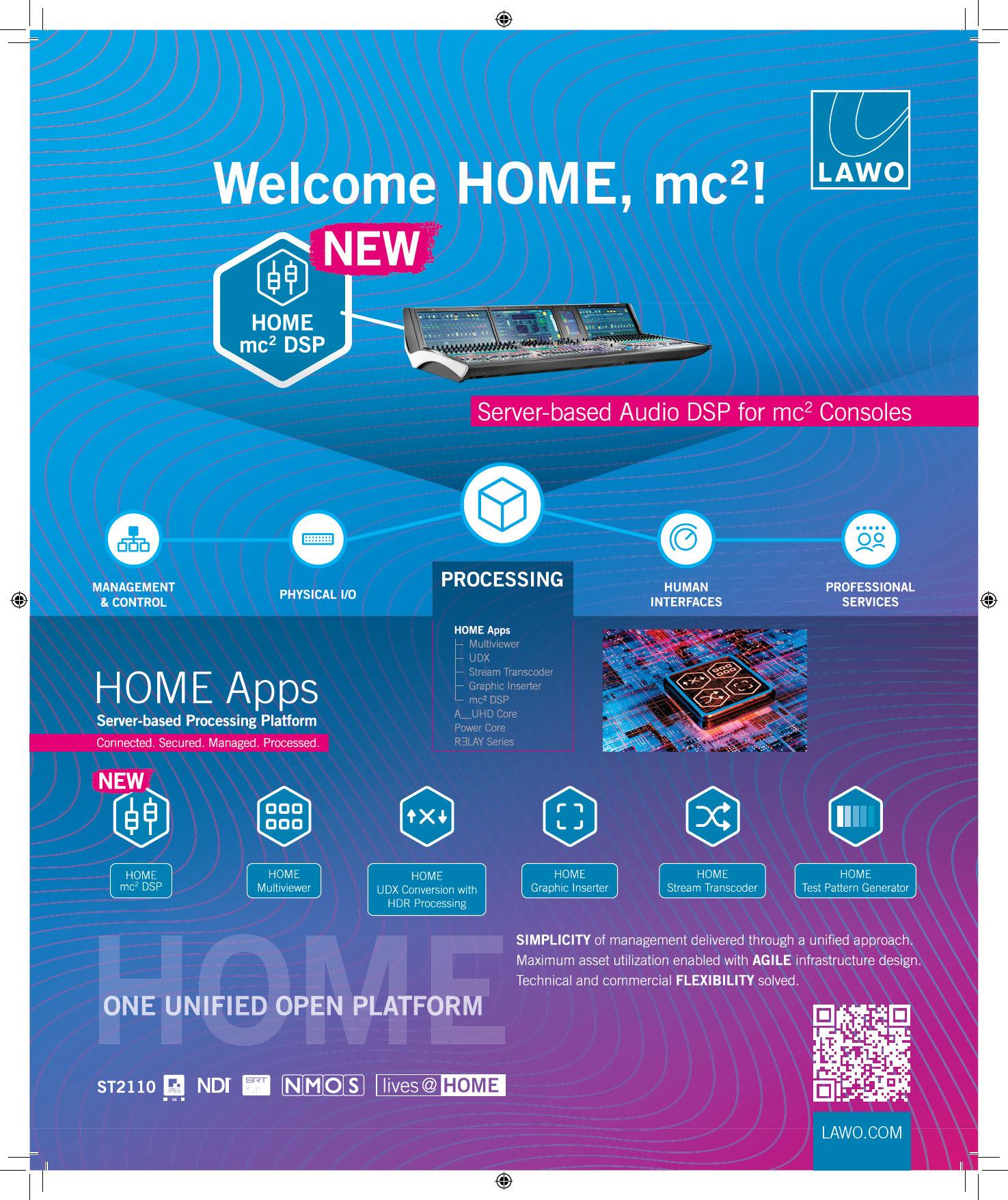
Top executives from Disney, Fox and Warner Bros. Discovery have consistently insisted that their joint venture to launch the Venu Sports streaming bundle in the fall of 2024 would not harm the pay-TV industry or accelerate cord cutting.
Right from the start, a number of analysts have doubted that assessment. Now a new survey from Aluma provides new notable and compelling data supporting the idea that the Venu service will negatively impact the already crumbling pay-TV industry.
The issue is important not only for payTV operators but also for broadcasters who have staked much of their financial future on extracting ever larger sums of money from retransmission consent deals with pay-TV operators.
In earnings calls right after the sports streaming service was announced, the backers of Venu Sports argued that the new service targets cord cutters and would not hurt the pay-TV industry.
However, the new Aluma Insights study finds that pay-TV subscribers are far more inclined than non-subscribers to sign up for the Disney, Fox, and Warner Bros. Discovery (DFW) sports bundle when it launches. One-in-five pay-TV subscribers are at least moderately likely to sign up for the DFW bundle, double the rate of those without
pay TV, reports Michael Greeson, principal analyst, at Aluma Insights.
The data is based on cost-averaged interest across three randomly and exclusively assigned price points: $29.99, $39.99, and $49.99 per month.
Among the pay-TV customers likely to sign up for the DFW bundle, 39% are at least moderately likely to cancel their pay-TV service as a result. And MVPDs are taking notice, Greeson explained.
“A loss of even 10% to 15% of the alreadydeclining base of paid subscribers would severely diminish the ability of operators to stay afloat,” noted Michael Greeson, principal analyst at Aluma. “And if those launching the DFW bundle intend to rely on demand from those without pay TV, they can forget about it. Less than one-in-ten are legitimate prospects for the service.”
In other words, the most lucrative audience for the DFW bundle is pay-TV subscribers, not at all what MVPDs want to hear, Greeson noted.
The data comes from March and April 2024, when Aluma Insights surveyed 2,032 US adults that use a broadband internet service at home, watch TV at least once a month, and who make or share in making decisions about their household’s TV and video services. George Winslow


In another important example of how high-profile sports rights are shifting to streaming, Roku last month secured exclusive multi-year rights for Major League Baseball (MLB) Sunday Leadoff live games.
Starting May 19, Roku began offering Sunday MLB games for free on The Roku Channel. It’s also offering an allnew “MLB Zone” to help baseball fans discover live and upcoming games, nightly recaps, highlights and a fully programmed MLB FAST channel.
On most Sundays throughout the season, Roku is now the home for the first games of the day, with an exclusivity window during airtime as well.
The MLB also reported that paying subscribers of MLB.TV can watch all 18 matchups blackout free from anywhere in the world.
“As television programming, live sports, and the leagues have fragmented across networks, apps, and multiple packages, Roku—home to all of them—plays an increasingly crucial role for viewers and advertisers,” said Charlie Collier, president, Roku Media. “With this deal, Roku delivers free, live, weekly Sunday baseball and 24/7 baseball curation, destinations, and channels across our platform. The leadin to all of television is now the lead-off for Sunday baseball as well. It’s a terrific partnership.”
MLB Sunday Leadoff streams every Sunday—which started on May 19 with the St. Louis Cardinals hosting the Boston Red Sox—are now streaming on The Roku Channel and TheRokuChannel.com until Sept. 15. George Winslow

Could 3.0 datacasting someday fund a gentle shutoff of ATSC 1.0?
 Phil Kurz
Phil Kurz
It’s amazing what can happen in just a few years. Not too long ago, ATSC 3.0 proponents and skeptics would go round and round arguing for and against NextGen TV.
But since LG Electronics, Samsung and Sony blazed the 3.0 consumer trail at CES 2020 with their introduction of the first NextGen TVs, the naysayers have had progressively weaker arguments as broadcasters and CE makers alike achieved a succession of milestones on the way to a successor TV standard. Without question, there have been some setbacks along the way, but the direction and momentum are clear.
Perhaps the last bastion for skeptics was datacasting. ATSC 1.0 supported datacasting, but it never lived up to its commercial potential. “Why should it be any different with 3.0?” they would ask.
But as the saying goes, “the proof of the pudding is in the eating,” and with several important datacasting developments at the 2024 NAB Show, reported in last month’s column, it seems 3.0 proponents and skeptics alike are about to get a big spoonful and determine for themselves whether delivery of IP packets via broadcast for third-parties eager to find affordable alternatives to unicast wireless networks is a viable 3.0 business.
Presuming initial rollouts are successful, it’s likely more broadcasters will wish to jump on board, making some of their bandwidth available for datacasting to capture their own slices of the pie.
The problem at the moment is the light-

house model used for the voluntary transition to NextGen TV leaves only a fraction of the bandwidth potentially available in markets in play for resale to data customers.
In most markets, broadcasters share single sticks and 6MHz channel assignments to deliver over-the-air NextGen TV. They’ve reshuffled the deck on the remaining towers and assignments to maintain their DTV main channels and digital subchannels.
The hope is that over time, consumers will replace their existing legacy DTV sets with NextGen TVs, making it possible to reshuffle available TV spectrum periodically, devoting more spectrum to 3.0 service and less to 1.0. Eventually, local broadcasters would end up sharing a tower and 6MHz channel assignment in their markets to maintain legacy DTV service—a “nightlight”—until consumers replaced the last dribs and drabs of ATSC 1.0 sets in their homes.
The problem is what to do about the Diginets. They require bandwidth. While it’s true broadcasters are only obligated to maintain their primary channel, it’s unimaginable that they would be willing to forego Diginet revenue by shutting them off simply on the hope of 3.0. Not only would station revenue suffer, but it’s highly likely many viewers would be miffed—some to the point of complaining to their representatives and the FCC.
However, I can only wonder if 3.0 datacasting revenue potential will prove to be so great that someday broadcasters themselves elect to pay for ATSC 3.0-to-1.0 converters for dwindling DTV viewers. That way broadcasters can complete the transition, maintain their OTA main channels and Diginets for first-gen DTV viewers and maximize the earning potential of their channel assignments by allocating a substantial portion of available bandwidth to meet the datacasting demands of a new group of clients.

Sony Pictures Post Production Services has announced that the final phase of a multi-year effort to expand and modernize its motion picture and television sound facilities has been completed.
As part of an effort to establish an inviting, state-of-the-art space for filmmakers and creative sound artists, the studio said it has integrated the latest immersive sound technology across 14 mix stages on its lot in Culver City. It has also made extensive aesthetic improvements. Its historic Cary Grant, William Holden, Kim Novak, Burt Lancaster and Anthony Quinn mix stages have been restored to sparkling condition, with new acoustics, cinema screens, creature comforts and creative support.
“We want filmmakers and sound talent to feel inspired when they walk onto our lot,” says Kimberly Jimenez, senior vice president, Post Production Services.
“We offer sound facilities that are at the highest level of technology in an environment that is warm and welcoming. There’s nothing like it in our industry.”
The project began in 2019 with the renovation of the studio’s 325-seat Cary Grant Mix Stage, one of the industry’s largest. To support immersive sound formats including IMAX and Dolby Atmos, the studio was equipped with new sound tech, including a dual 2 x 24 fader Avid S6 console, four Avid Pro Tools HDX-3 workstations, a 192-channel HDX-3 Pro Tools recorder and a stunning JBL speaker array. A 50’ x 20’ cinema screen and 4K projector complete the true theatrical experience.
George Winslow
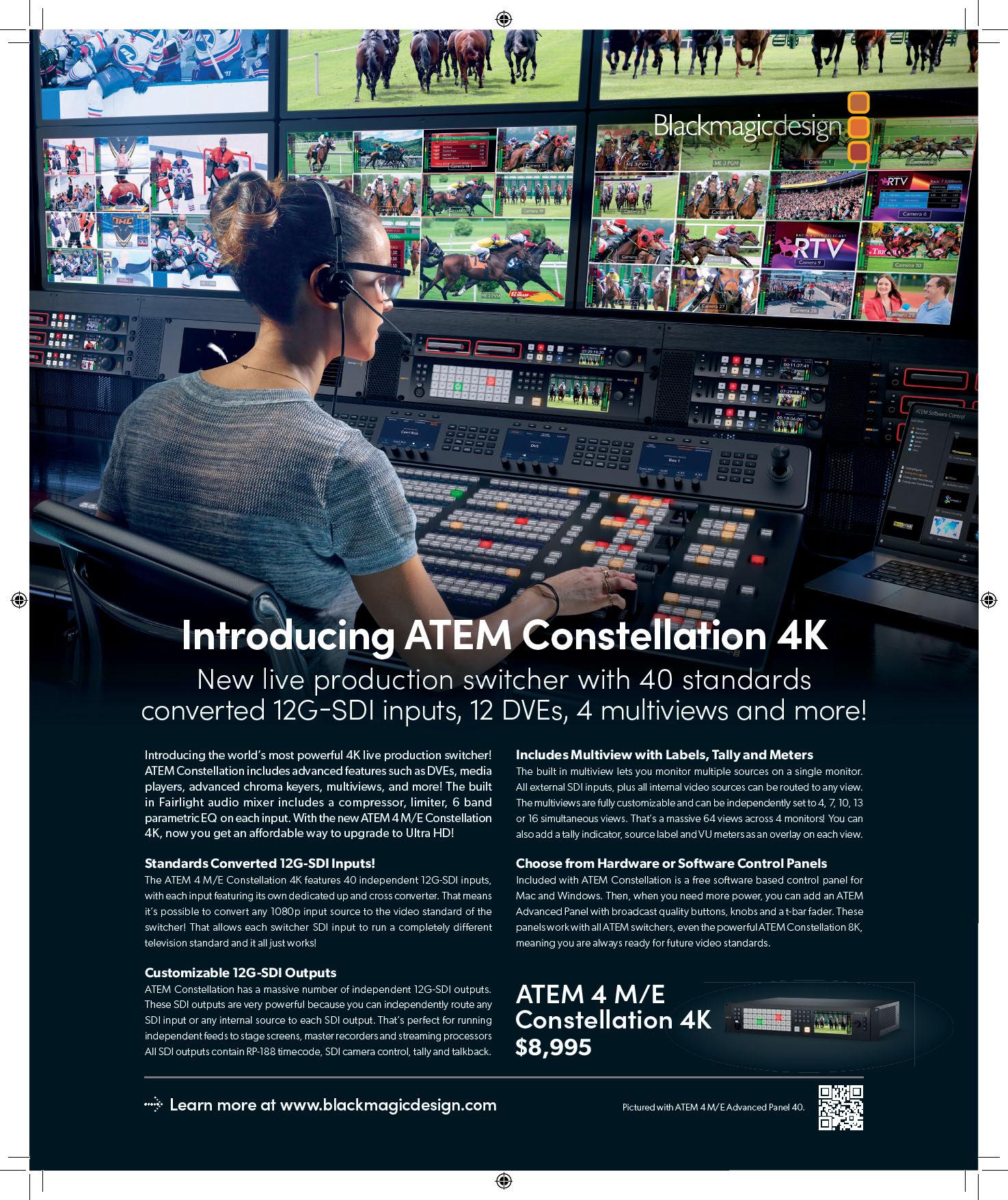
Broadcasters await the results of the ‘Future of TV’ task force and a 1.0 sunset
By Tom ButtsFifteen years ago this month, U.S. broadcasters “cut the cord” on NTSC, shutting down analog TV and putting the finishing touches on a transition to digital that lasted more than a decade.
Viewer response was fairly muted, but that’s because broadcasters, regulators and consumer electronics companies rightly anticipated an outcry if too many viewers lost access to a free over-the-air signal. Navigating the deadline to shut down analog was a frustrating process as all parties involved attempted to assemble the variety of moving parts that made up the transition.
In the summer of 2024, the industry is looking at the next shutdown—the end of ATSC 1.0. Despite the arduous task that faced broadcasters in the 2000s during the first transition, this next transition could be even harder to achieve.
Comparing the two transitions is apples to oranges. The first transition was mainly based on regulatory guidelines that in essence, forced industries to cooperate toward a common goal. The cable, broadcast and consumer electronics industries were also facing a far less complex media ecosystem where there was less competition for eyeballs. And perhaps the biggest factor was the decrease in prices for large screen 16:9 flat screens that aligned with broadcasters’ move to HDTV, a very noticeable and welcome advance for home viewers.
The transition to ATSC 3.0 (aka NextGen TV) is touted as “market-driven” with a lighter regulatory touch than the move to 1.0. There are no specific deadlines for stations to deploy the standard nor are there any mandates to provide tuners in any receiving devices. There aren’t any mandates for broadcasters to provide anything more than simulcasting ATSC 1.0.
And, in contrast to the first transition, broadcasters face a much more complex media landscape and Silicon Valley
competitors with far deeper pockets and much less to lose if a particular experimental service failed (remember Quibi?). It’s also harder to get viewers who are now used to getting their programs in 4K and HDR to get excited about 4K HDR broadcasts.
Mark Aitken, senior vice president of advanced technology for Sinclair Broadcast Group would beg to differ on that front.
“HDR is very significant, and one of the promises of the ATSC 3.0 standard is better television for America’s living rooms,” Aitken said at this year’s NAB Show. “It was the focus of the ATSC at this year’s CES. CBS’s delivery of the February Super Bowl LVIII in HDR should spur others to add this enhancement to their ATSC 3.0 transmissions and I expect to see announcements from other networks,” said Aitken, who added that some 40 Sinclair stations are on the air with Advanced HDR by Technicolor.
Aitken’s sentiments are echoed by Anne Schelle, managing director of Pearl TV, the consortium of broadcasters and manufacturers promoting NextGen TV, who discussed how local Louisville, Ky. TV stations promoted HDR, 4K and Atmos immersive audio in their local 3.0 broadcasts during the week leading up to the 2024 Kentucky Derby. Local stations partnered with a local retailer to give away NextGen TV sets and promotions on their websites attracted “a significant increase in traffic.”
“I think that is a good indicator of the interest in HDR,” she said. Schelle also noted Pearl’s recent announcement that several large station groups, including Gray Television, Sinclair Broadcast Group, Hearst Television, Tegna and The E.W. Scripps Co. will accelerate funding of the ATSC 3.0 Framework Authority (A3FA), the driving force behind the RUN3TV platform. Pearl TV

Last month, San Antonio announced the addition of five more TV stations to broadcast in 3.0, enabled by a

says it expects additional broadcast groups to become involved in the future.
“RUN3TV is built by broadcasters for broadcasters and it allows companies who built on the platform to easily build applications and try out unique features and have them be able to work across the multitudes of operating systems that are currently out there and more to come,” she said.
A new partnership with ROXi to launch interactive music channels, as well as NBC’s announcement that affiliates in top markets are launching ancillary services via NextGen TV were among the other 3.0 highlights announced at the NAB Show in April.
Beyond consumer applications, broadcasters are also using a portion of their spectrum to deploy new datacasting services. Also at the NAB Show, Sinclair launched its “Broadspan” datacast service in partnership with Edgio. The new service will enable data distribution in all the current markets where Sinclair stations are offering ATSC 3.0 broadcasts. Sinclair CEO Chris Ripley invited other station groups to join the service.
While all of these new capabilities are brought to us via the ingenious capability of ATSC 3.0’s combination of broadcast with IP, there’s only so much bandwidth available and that bandwidth is further constrained by the 1.0 simulcasting requirement.
At presstime, ATSC 3.0 has been launched by more than 91 stations in 40 markets, bringing the advanced broadcast standard to within reach of more than 75% of U.S. households. Pearl TV says it expects that number to grow to more than 200 stations in 53 markets by the end of 2024.
Most of those stations are simulcasting 3.0 with 1.0 over “lighthouse” transmission partnerships in which one local station offers up its transmission facilities to “host” the other 3.0 stations in particular markets. This requirement is in place during the transition to ATSC 3.0. Originally, the FCC imposed a 2025 deadline to end 1.0 simulcasting but in 2023, moved the date to July 17, 2027. The decision was in part predicated by the industry’s exhortations to the commission earlier in the year about a “stalled” transition.
In response, FCC Chairman Jessica Rosenworcel announced the formation of the “Future of TV” task force at the 2023 NAB Show, inviting all industry players to work together towards a successful conclusion of the transition to 3.0.
“This Future of Television initiative will

gather industry, government, and public interest stakeholders to establish a roadmap for a transition to ATSC 3.0 that serves the public interest” Rosenworcel said at the time. “A successful transition will provide for an orderly shift from ATSC 1.0 to ATSC 3.0 and
place before it replaces 1.0 with 3.0 and the consumer electronics industry’s vehement opposition to any Congressional tuner mandates, it’s understandable that the task force may not arrive at a definitive deadline that will please everyone.
“[The transition] has worked better than the government-mandated transition 20 years ago, we are moving ahead faster.”
ROB FOLLIARD, GRAY TV
will allow broadcasters to innovate while protecting consumers, especially those most vulnerable.”
‘FRANK’ AND ‘CANDID’
The FCC asked the NAB to take the lead by hosting the meetings, and while the industry has been tight-lipped about characterizing the tone, the best the press has been able to get out of sources is that they are “frank” and “candid,” which, in Inside the Beltway-speak, can have a wide variety of meanings.
But given the cable industry’s long-held viewpoint that certain guardrails must be in
The NAB, for its part, is staying on message. “The Future of TV initiative has made great progress, and we are looking forward to releasing the report later this year,” they told TV Tech. “We appreciate the participation of everyone involved in this effort to help ensure a smooth transition.”
ATSC President Madeleine Noland agrees that ending the transition is top of mind for broadcasters, noting that until a deadline is established, broadcasters are finding ways to add more capabilities despite the bandwidth constraints.
“As exciting as datacasting is, until the transition is farther along—and I don’t mean getting from 75% to 100%—but I mean within a given market, it’s important to have more transmitters available with 3.0. I think about the Boston market and we have one transmitter up, which is carrying five or six high-definition signals and at least two standard-definition search services. There’s not a lot of room to do anything else.”
Noland mentioned the recent addition of five more 3.0 stations in the San Antonio market as one of the ways around such constraints. “I gotta tip my hat to San Antonio for being able to get that second stick up.“ Noland said, adding that the current focus will not be in trying to finish the other


25%, but in expanding coverage in existing markets. “Let’s try to get depth in the markets that we already have because we’ve got all the big markets; let’s build it out and be able to do more with 3.0 in those markets.”
The transition to ATSC 3.0 contains an insane number of moving parts as well as a variety of approaches and while no one is suggesting Congressional mandates of any kind, in its current state, there remains some question as to whether it will survive its status as a completely market-based transition.
But don’t tell that to Rob Folliard, senior vice president of government relations and distribution with Gray TV and chairman of Pearl TV who says the transition to 3.0 is moving at a faster pace than the move to 1.0.
“[The transition] has worked better than the government-mandated transition 20 years ago, we are moving ahead faster,” Folliard said. “And I think the reason the market-based approaches work is because the broadcasters see a huge opportunity, a huge ROI, and we’re making it work. We’re finding creative ways to cooperate, channel share, in order to make the transition happen.”l


The broadcast industry’s accelerating transition to cloud-based production of sports, news and other live programming is proving far more disruptive to the evolution of video services than seemed likely not so long ago.
The impact came into dramatic focus at the NAB Show, where the paradigm shift was revealed as the inevitable result of industry-wide adoption of SMPTE 2110 in support of the SDI-IP transition. “The whole explosion around cloud production wouldn’t have happened without 2110,” noted Steve Reynolds, president of Imagine Communications.
Widespread adoption has driven costs down to where “2110 has become cheaper than SDI on a per port basis,” leading to
experiences with on-premises IP-based news, sports and other live productions that have made workflows “a lot better,” he said. As a result, producers are now comfortable with exploiting the cost savings and collaborative flexibility that comes with moving production to the cloud.
NAB Show exhibit halls teamed with cloud production-related solutions aimed at enabling a streamlined, cost-saving approach to launching linear TV channels combining any mix of live and file-based content for any distribution model, whether it be free-to-air broadcast, pay TV, SVOD, AVOD, or FAST. Now, as Reynolds put it, “FAST is just TV.”
An unavoidable testament to the significance of the cloud-to-live broadcast production was the expanded show floor presence of AWS. The superscalar has been benefiting from broadcast industry

demand for cloud support for many years, including in the live production arena, but the pace and scale of developments now are unprecedented, said Chris Blandy, director of strategic business development for M&E, games, and sports at AWS.
“There are now more than 4,000 linear channels originated over AWS around the world,” Blandy noted. Much of this activity revolves around collaborations in linear channel development involving combinations of live and file-based content. These AWS customers’ workflows “are bringing in editors, graphic artists, colorists wherever they happen to be while relying on us to maintain tight security in their operating environments,” he said.
AWS demonstrated live news production from the show floor as a way to call attention to what’s happening in the rapidly evolving broadcast news arena. “We’ve seen a lot of innovation in this space, and now we’re seeing it mature into stable production workflows,” Blandy said.
Indeed, as Imagine’s Reynolds noted, cloud production is a big boon to TV stations looking to leverage their unique opportunities to build audiences by streaming local news and other live content. “Station owners can take advantage of remote production using their subchannels to deliver local live content,” Reynolds said. “It gives them new capabilities to differentiate their programming.”
In the sports world, the shift to cloud production has been slower than in other M&E segments, but now producers are increasingly implementing hybrid transitions that are pushing ever more processes to the cloud while retaining a significant on-prem production presence, noted Deon LeCointe, director of networked solutions at Sony Electronics. With a focus on SE’s Networked Live product portfolio, LeConte has a bird’s eye view of how the company’s preparations for this phase in live sports production is paying off.
SE’s Networked Live solutions come into play with transitions to cloud production anchored
by the Nevion VideoIPath media orchestration platform, which Sony acquired in 2020 and has since enhanced to work with SE’s broadcast control solutions. The result, LeConte said, is a highly scalable, ultra low-latency platform that uniquely combines broadcast operations, orchestration, and monitoring capabilities in hybrid workflows across SDI and IP LAN, WAN. cloud, and 5G networks.
“The whole explosion around cloud production wouldn't have happened without [ST] 2110.”
STEVE REYNOLDS, IMAGINE COMMUNICATIONS
At the NAB Show, SE demonstrated seamless hybrid production through a control panel managing the firm’s software-based M2L-X switcher for cloud operations and the modular MLS-X1 switching appliance for premises-based operations. “We think this is
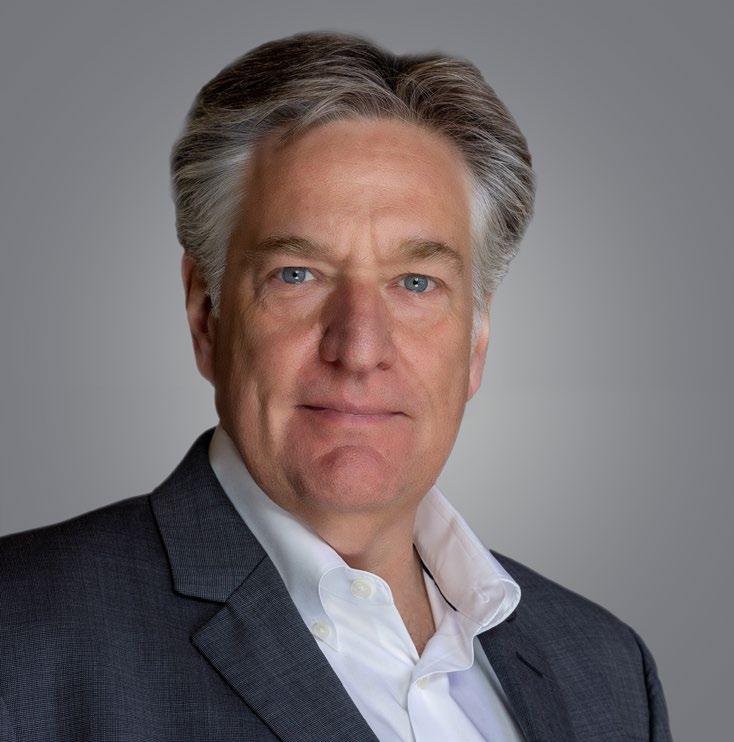
the best approach for sports operations that are pushing the envelope toward the cloud,” LeConte said.
The National Hockey League made news at the NAB Show as the first big pro league to take the plunge into full cloud production mode. This is enabling the league to deliver personalized experiences to connected
devices in and beyond game arenas along with traditional TV broadcasts while substantially reducing costs, said Grant Nodine, senior vice president of technology for the NHL. “With the ability to spin up and rent resources as needed, it doesn’t make a lot of sense to be putting big production trucks in venue,” Nodine said.
The transformation in user experiences across all locations is enabled by a partnership with Verizon as provider of 5G connectivity to in-venue audiences and between the game arenas and the AWS cloud, where productions for in-venue audiences are returned for viewing in sync with live action and productions for external distribution are sent out over the usual channels. “We’re using the cloud as the router of the future,” Nodine said.
The implications of cloud production as the center of gravity for streamlining the supply of linear content across all business models and distribution outlets were top of mind across the playout ecosystem in Las Vegas. “FAST and broadcast used to be separate,” said Dan Marshall, executive vice president for worldwide sales at Amagi. “Now we’re

seeing the integration of live content into FAST channels.”
Amagi, like many suppliers, is reconstituting itself to take advantage of the transformation. Traditionally positioned as a provider of playout services, Amagi for some time has been responding to the FAST phenomenon by helping customers with insertions of ads, graphics, QR codes and other elements in live production, according to Marshall. Now the company has gone all the way into support for live production with acquisition of the Polish cloud production supplier Tellyo.
Amagi, in response to the emergence of high-value live programming in the FAST channel mix, has teamed with digital rights management platform supplier Intertrust to enable implementation of license-mandated security in its playout workflows. With the success of FAST, which now accounts for 25% of TV ad views in the U.S., according to Comcast’s Freewheel unit, Marshall and others said it’s just a matter of time before major sports become part of the FAST lineup, and, sure enough, just before press time, Roku announced that, in a new deal with Major League Baseball, it was becoming the first FAST channel producer to be carrying games from a major pro sports league (see p, 6).
The move of live production to the cloud has realigned the interplay between production and playout in new workflow configurations that rely on ultralow latency connectivity for synchronized execution of tasks wherever they occur. The disruption to past norms is pushing some vendors in new directions and playing right into where others have been from the start.
As a leading player in the latter category, LTN has touted a multi-pronged set of turnkey FAST, addressable advertising, production, and playout solutions, all of which are closely linked to the global B2B LTN Network serving as a unicast/multicast playout alternative to satellite distribution.
“We’ve been hearing about the shift to IP and cloud production for well over a decade, and even two years ago we were saying it’s no longer a matter of if, but when,” said LTN CTO Brad Wall. “Now it’s here with a focus on what tools and workflows are out there ready to use with low latency and high reliability.”
The company offers LTN ARC as a fully managed playout system, which Wall said sports producers are leveraging to “manage and customize premier sports at global scale.” He cited a tier one producer delivering soccer games in multiple
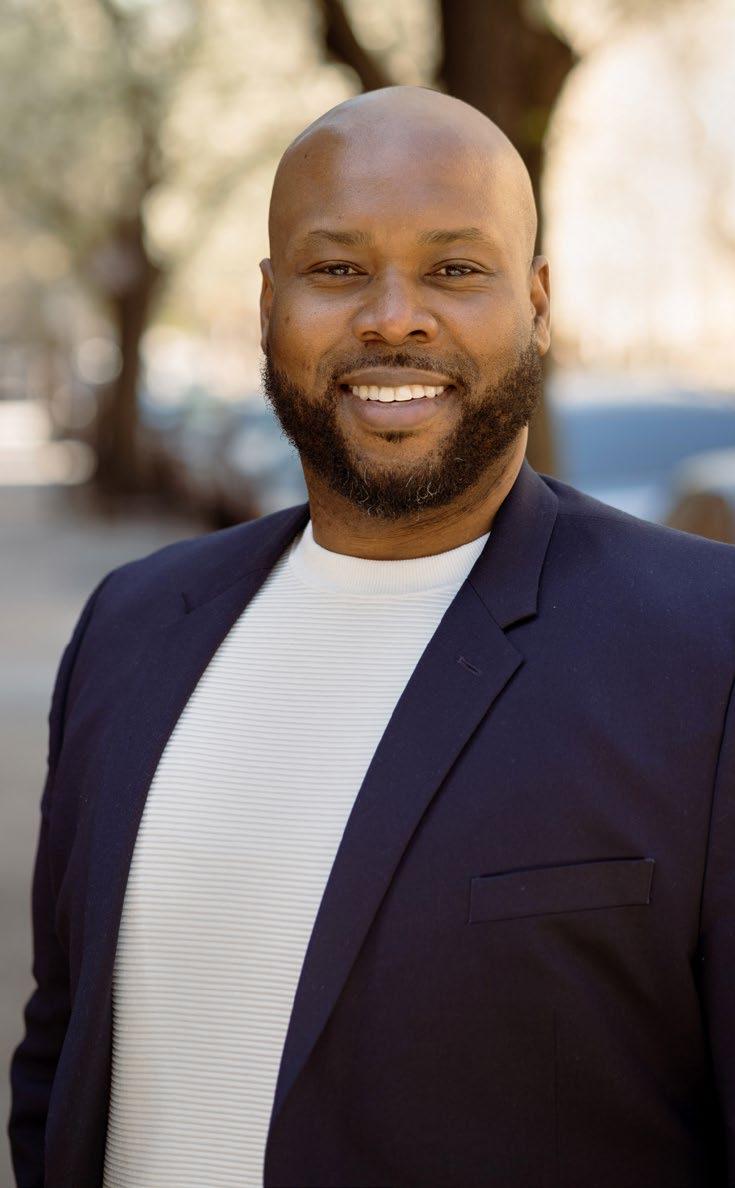
versions matched to licensing and language requirements as an example of how sports producers are overcoming the marketspecific production limitations of the past. Whether they use ARC or the self-managed LTN Lift playout technology, producers can leverage the new IP production paradigm whether on premises or in the cloud to “empower these types of workflows with all kinds of new branding and marketing opportunities,” Wall added.
“We’re using the cloud as the router of the future.”
GRANT NODINE, NHL
Another company capitalizing on a solution set built from the ground up for this moment is Mediagenix, which offers a software-as-a-service (SaaS) platform enabling broadcast networks and streamers to manage monetization and scheduling of live and stored content across broadcast and OTT footprints. “True transformation is finally happening,” said Mediagenix Chief Product and Marketing Officer Ivan Verbesselt.
“FAST is an example of the business growing
up,” he added. “We shouldn’t be building platforms to accommodate business models. We should build business models first using platforms that enable business agility.”
Toward that end Mediagenix has developed tools that allow media companies to manage the complete content life cycle with seamless organization-wide collaboration, Verbesselt said. Platform intelligence, often with AI assistance, enables highly efficient approaches to formulating and budgeting value management strategies, leveraging audience data in the use of metadata, orchestrating dubbing, subtitling, and graphics, scheduling placement in FAST and other channels based on AI predictive ratings, and much else, he explained.
One of the more arresting innovations supporting cloud production comes from Matrox Video, a company best known as a leading decades-old supplier of line cards, encoders, extenders, switches, and other production hardware to OEMs. But in Las Vegas, its focus was on tools that add efficiencies to SDI-to-IP points of conversion and that support connectivity enabling synchronized collaboration across cloud production workflows.
Matrox describes its ORIGIN ultralow latency framework as a “groundbreaking approach” to linking workstations. According to Francesco Scartozzi, vice president of sales and business development for the Matrox Broadcast and Media Group, ORIGIN tailors high-end IT operations to broadcast TV requirements so that each set of tasks in the production process is executed with frameaccurate synchronization across all relevant points of collaboration on the workflow, whether hardware related to the task at hand is positioned on premises on in the cloud.
“ORIGIN is built on a media-aware content transfer fabric,” Scartozzi explained. It treats production applications as completely independent stateless media services sharing a common storage infrastructure with reliance on a mode of low-latency transport that he described without elaboration as “our secret sauce.”
By all appearances, there’s nothing left standing in the way of the transition to live programming production in the cloud other than the remaining life spans of premisesbased equipment.
And once those who haven’t yet moved to the cloud start feeling the impact of service innovations introduced by those who have, it wouldn’t be surprising to see a good bit of cost/benefit analysis justifying reductions in those life spans. l
will AI take the M&E industry? We’re just starting
“Matrix” is a word with many different meanings, but they all share the idea of connecting different things into one. In our industry, we often use it to describe the switching equipment that connects signals to various destinations, like an SDI (Serial Digital Interface) “matrix.”

I decided to name this column “The Media Matrix” because I will discuss how many new technologies are linked to media. Using technologies as varied as cloud computing, analytics and AI (Artificial Intelligence), media technologists are constantly changing our companies, the way that creators make content, and how audiences enjoy it.
I will share this space with industry leader Karl Paulsen, where we will talk about the future of tech in media. We are ready to dive into any hot tech trend that pops up and share our insights.
Like the 2023 show, AI was clearly the buzzword at the NAB Show in April and we are going to zoom in on that first. There are many aspects of our business that will be impacted. From preproduction to distribution, every step of the media workflow has the potential to be transformed as AI evolves. One of the first things that struck me in Las Vegas was how few booths had AI plastered all over them. Sure, there was a lot
of buzz about AI at the show, but I thought every booth would have something akin to a flashing neon sign.
Maybe it’s because AI is not new to our industry, and we’ve learned to tone down the hype just a bit. I think technologists are looking for real examples they can apply to their operations now for practical use. There are some areas in media where AI is solid and ready to go—you can see for yourself how subtitling and language translation and even voice generation are working well. You can use AI to analyze content and add metadata to make it easier to find and use. You can use AI in post to improve images or create mattes. These and other use cases are worth exploring and implementing now.
At the conference sessions I managed to attend or speak at, there was also a lot of talk about the future possibilities of AI.


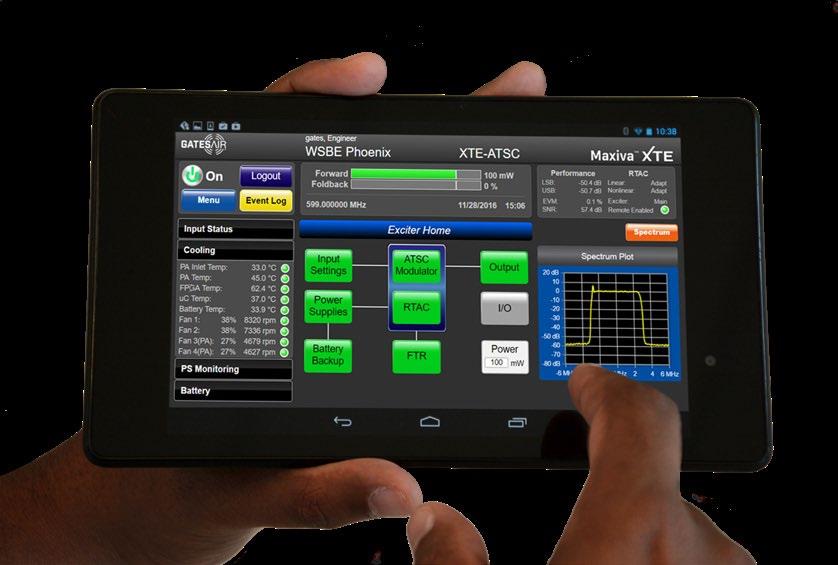









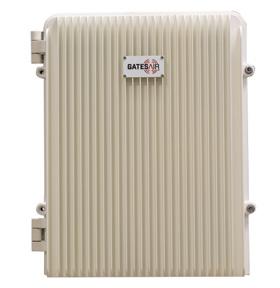
While people often worry about fake content, in one session there were discussions about how AI can help bring more facts to journalists or directly to viewers in news and sports content genres. There were also discussions about how AI can help personalize content in digital distribution.
What I found most interesting were the number of seasoned technologists who were saying how we’ve seen this kind of disruption many times in media and how the “doom and gloom” predictions about how such disruptions impact creativity or jobs are often wrong.
In the next few months, we’ll have a lot of interesting topics to cover here:
Defining AI: What is AI? What are the different kinds of AI? How does AI relate to machine learning? What is the future of AI? What are the limits of AI? How do various types of AI work under the hood? Is the future the big models that get all the attention now, or smaller, more focused approaches to AI?

I tried generating a hype cycle graphic for AI. I think I was too optimistic! Ideas for successful prompts welcome!
Workflows and Integration: What parts of the workflow in a media company can benefit from AI and how? How do we make AI work well with other technologies in our workflows? What standards are there for interacting with AI and what standards should media develop?
People and Management: How will AI affect jobs in the media and entertainment industry? What skills do technical folks need to learn to be ready for more AI in their work? How do we deal with the human side of change?
Infrastructure and Architecture: How do we set up our computing and storage layers to handle the heavy AI load in our environment? How do we design our data layer to improve the quality of data used to feed and train models? How do software application layers talk to AI models? Do we have enough power, cooling, and space to run all this stuff?
Cost and Financial: How much does AI really cost and is it worth it in different use
cases? Are there ways to optimize the realworld costs of AI? How can we monitor the technology to give us efficiency insights?
“One of the first things that struck me in Las Vegas was how few booths had AI plastered all over them.”
Creativity: Can AI take over various craft or creative functions? How “creative” can we expect AI to be? What new content types or genres will AI enable in the media space?
Rights and Legal: What are the intellectual property issues with AI? How do we make sure that AI outputs won’t put our business at risk? What technological controls can we use to help protect the business?
Viewer Response: Do viewers really want a lot of highly personalized content? What about genres like sports where the shared experience is part of the value? As we collect more data about viewers how can we protect their privacy and ensure appropriate controls?
These questions are not all purely technical, but technology issues have been merging with business issues since media adopted IT practices. Today’s broadcast engineers are always asked to evaluate their technology investments through a business lens.
We won’t just talk about AI here. We have some slightly older tech trends still evolving like cloud and blockchain and many more. Interestingly, all these trends intersect with each other. For example, the C2PA (Coalition for Content Provenance and Authenticity) specification is a new approach for content provenance that uses watermarks and blockchain technologies to deal with critical issues like the risk of fake AI content in our ecosystem.
But let’s be honest. We are at the start of the hype cycle for AI, and it’s important to be well-informed on the subject for the many discussions that are coming and so we’ll focus there first.
Writing this column is something I’m very excited about. I’ve been in the media technology field for more than three decades, and it just keeps getting better and more fascinating. l
With more than three decades of M&E experience under his belt, John Footen is a managing director who leads Deloitte Consulting LLP’s media technology and operations practice. He has been a chairperson for various industry technology committees. He earned the SMPTE Medal for Workflow Systems and became a Fellow of SMPTE. He also co-authored a book, called “The ServiceOriented Media Enterprise: SOA, BPM, and Web Services in Professional Media Systems,” and has published many articles in industry publications.
This month I’ll focus on what I saw on the exhibit floor at NAB Show. This isn’t a comprehensive overview of all the RF and transmission exhibits and show news—other articles in TV Tech do that well. Instead, I’ll be looking at a few exhibits I found interesting. Next month I’ll discuss other RF technology topics from the show, including BPS and 5G Broadcast.

Many broadcasters purchased Rohde & Schwarz THU-9 transmitters during and after the repack, so I wasn’t surprised that Rohde’s unveiling of its new UHF TV transmitter, the TE1, attracted a large crowd Monday afternoon despite its location in the South Hall, far away from other transmitter and distribution exhibits.
Some of the changes are apparent looking at the transmitter. Unlike the THU9, which was designed for worldwide use, the TE1 was designed specifically for the U.S. market where higher power transmitters are required. The exciters mount horizontally in the rack, allowing up to 14 amplifiers per cabinet and increasing the per-cabinet output power to 24.5 kW. Looking at the back of the transmitter, you can see the changes in the combiner output and load. Also, the power input is now at the top of the cabinet, cleaning up the wiring on the right side (from the rear) power distribution panel. (The colorful LED cabinet lighting in the photo is not available as an option.)
The exciter includes the ATSC 3.0 modulator—a separate SDE-900 unit is not required. Reflecting the TE1 North American market focus, the specifications show ATSC and ATSC 3.0 as the only supported standards. The product brochure says it is “Prepared for 5G Broadcast.”
END-TO-END ATSC 3.0
TRANSMISSION SYSTEM
Anywave showed a complete ATSC 3.0
signal chain that will make it easy for broadcasters, particularly LPTVs, to switch to ATSC 3.0. It includes the encoder, gateway and scheduler, and exciter.
A key feature of the gateway/ scheduler is a custom design using FPGAs rather than software running on a server. This enables a complete ATSC 3.0 encoder, gateway/scheduler and exciter in three rack units of space to consume a fraction of the power

required for a server-based system.
Their AW9200 Exciter+ can be configured for use as a translator for ATSC 3.0 with a gateway option that allows modification of signaling at the translator site without additional gateways.
As transmitters become more efficient, engineers are taking a closer look at the power consumed by dummy loads in systems with multiple transmitter cabinets. When one of the cabinets shuts down, the combiner
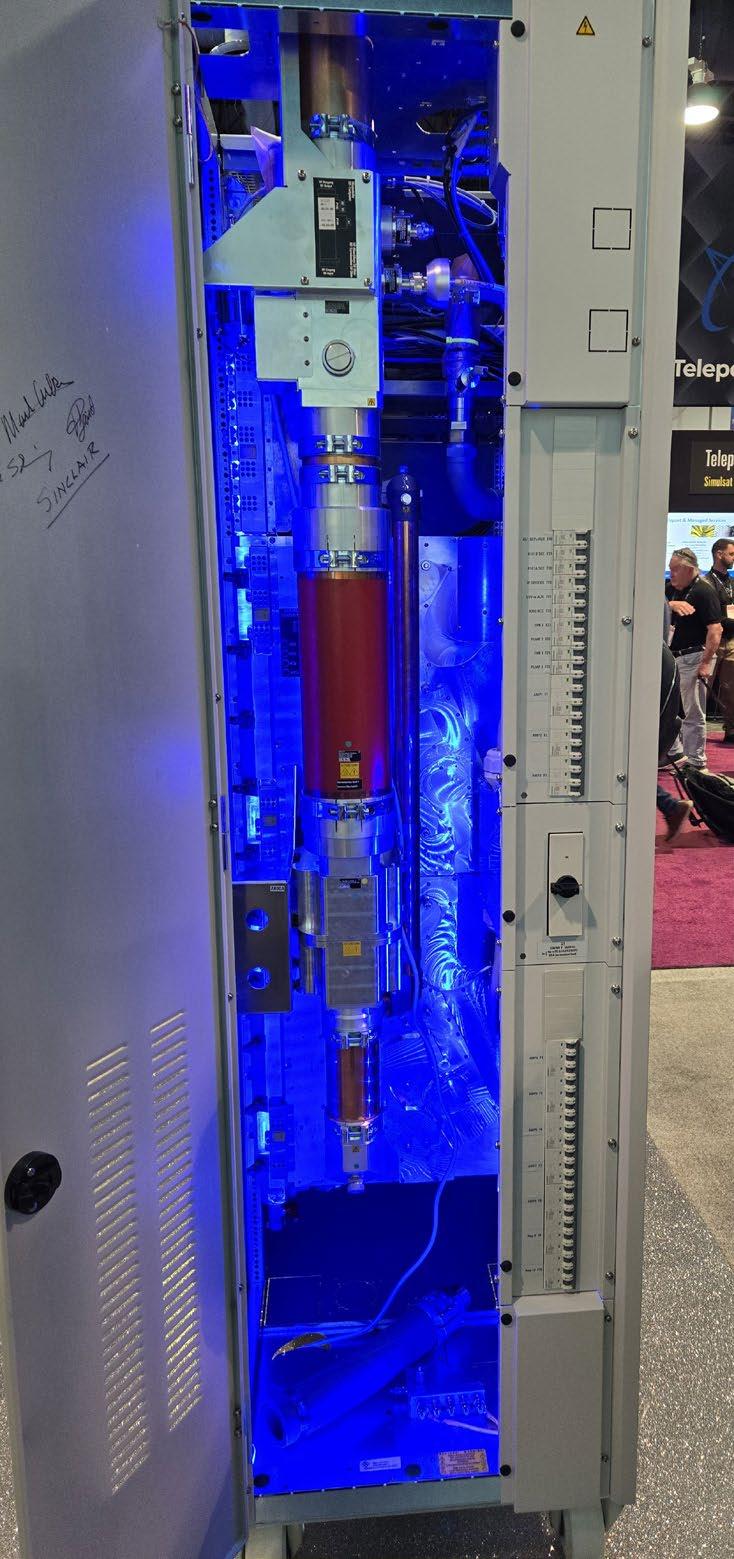
becomes unbalanced.
In a two-cabinet system, this results in half the remaining power going into a reject load. This doesn’t happen that often, so any power used to cool the dummy load while both cabinets are operating normally is wasted.
Dielectric’s solution is the “OptiLoad,” which turns on the cooling pumps only when required. This is more complicated than it sounds. If the reject load fails, it will shut down the entire transmitter. Worse, if it fails to shut down the transmitter and a cabinet fails, the coolant pressure and steam generated by the load can cause a mess before the reflected power takes down the transmitter. The OptiLoad includes RF sensors and other features designed to prevent such disasters.
Most ATSC 3.0 stations set their modulation and coding and PLP configurations once and don’t change them. Triveni showed its “Station Manager,” which makes setting, storing and restoring ATSC 3.0 configurations easier.
Anyone who has looked at the ATSC 3.0 standard knows there are an almost infinite number of configurations available. Changing one parameter can require changing another parameter to maintain a legal ATSC 3.0 stream. The Station Manager interface makes this easier.
I can also see how Station Manager could become an important part of the broadcast core network, which will allow broadcasters to offer excess data capacity for other uses, such is IoT. This will likely require participating broadcasters to change their transmission parameters to accommodate demand for data delivery with different bandwidth and robustness requirements.
Many engineers see the ATSC 3.0 Broadcast Positioning Service (BPS) as a key driver of ATSC 3.0 support from the government and perhaps device manufacturers as well. I’ve discussed BPS before and will have more on it next month, but wanted to highlight one product that will make it easier for broadcasters to add BPS capability to their transmission systems. Stations that want to transmit BPS signals will need to precisely time the transmission of the ATSC 3.0 bootstrap.
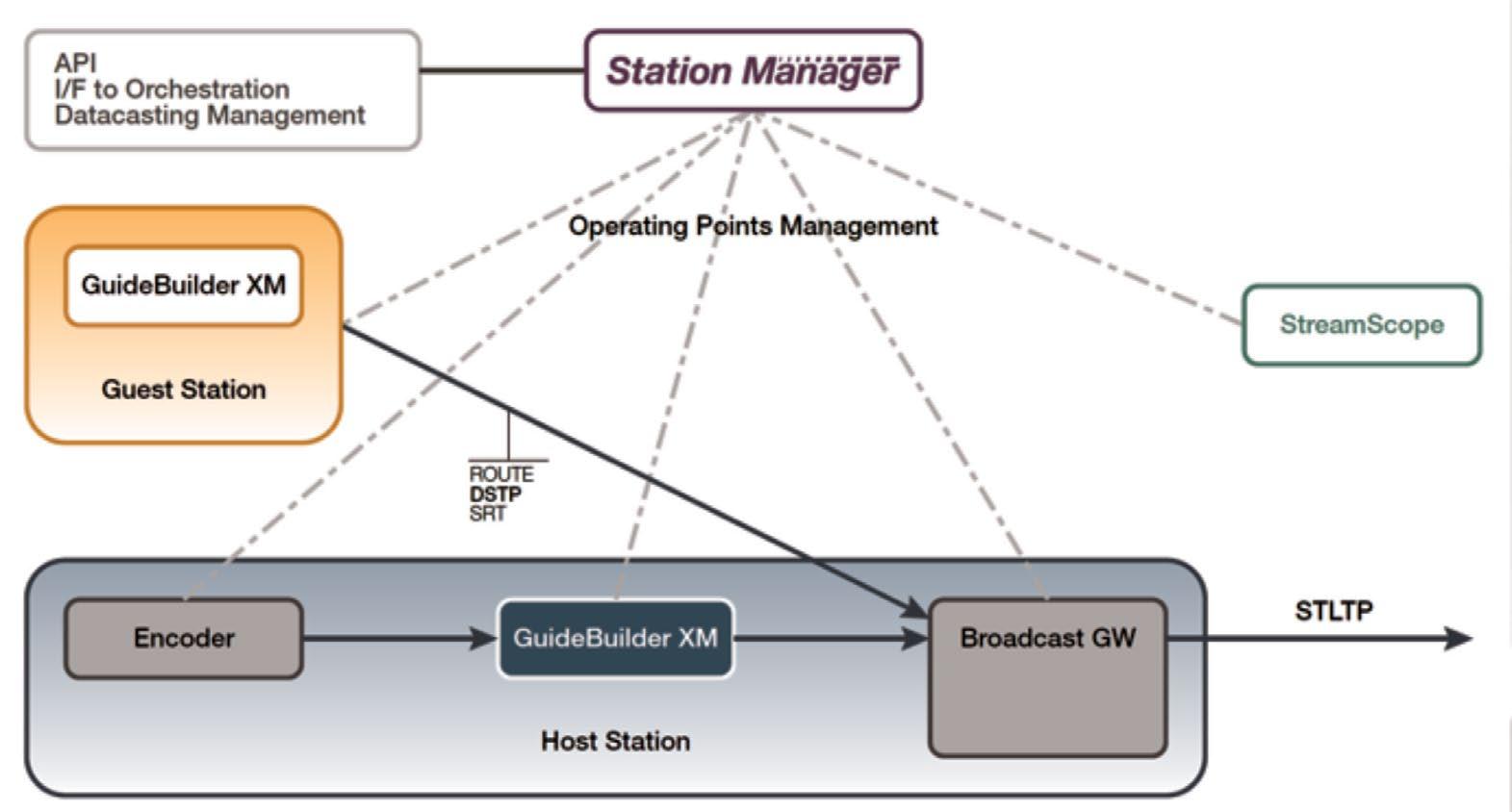
The Avateq AVQ-1050 consists of a BPS receiver and a BPS synchronizer, which together compare the received signal with a reference clock and adjust the transmission time to make it a stable, precise time source. It can directly control the transmission time from a Rohde & Schwarz exciter without connection to the gateway and scheduler, which may not be located at the transmitter site.
there will be a need for cable companies to receive ATSC 3.0 signals. While the ideal scenario would be for the cable companies to deliver a stream that enables most of the ATSC 3.0 features, during the transition, they will need to convert the ATSC 3.0 to a form that will work with their existing set-top boxes. To that end, the Sencore TXS3800 ATSC 3.0 to ATSC 1.0 transcoder can provide decryption and transcode video and audio from ATSC 3.0 to ATSC 1.0 formats in an ATSC 1.0 transport stream.
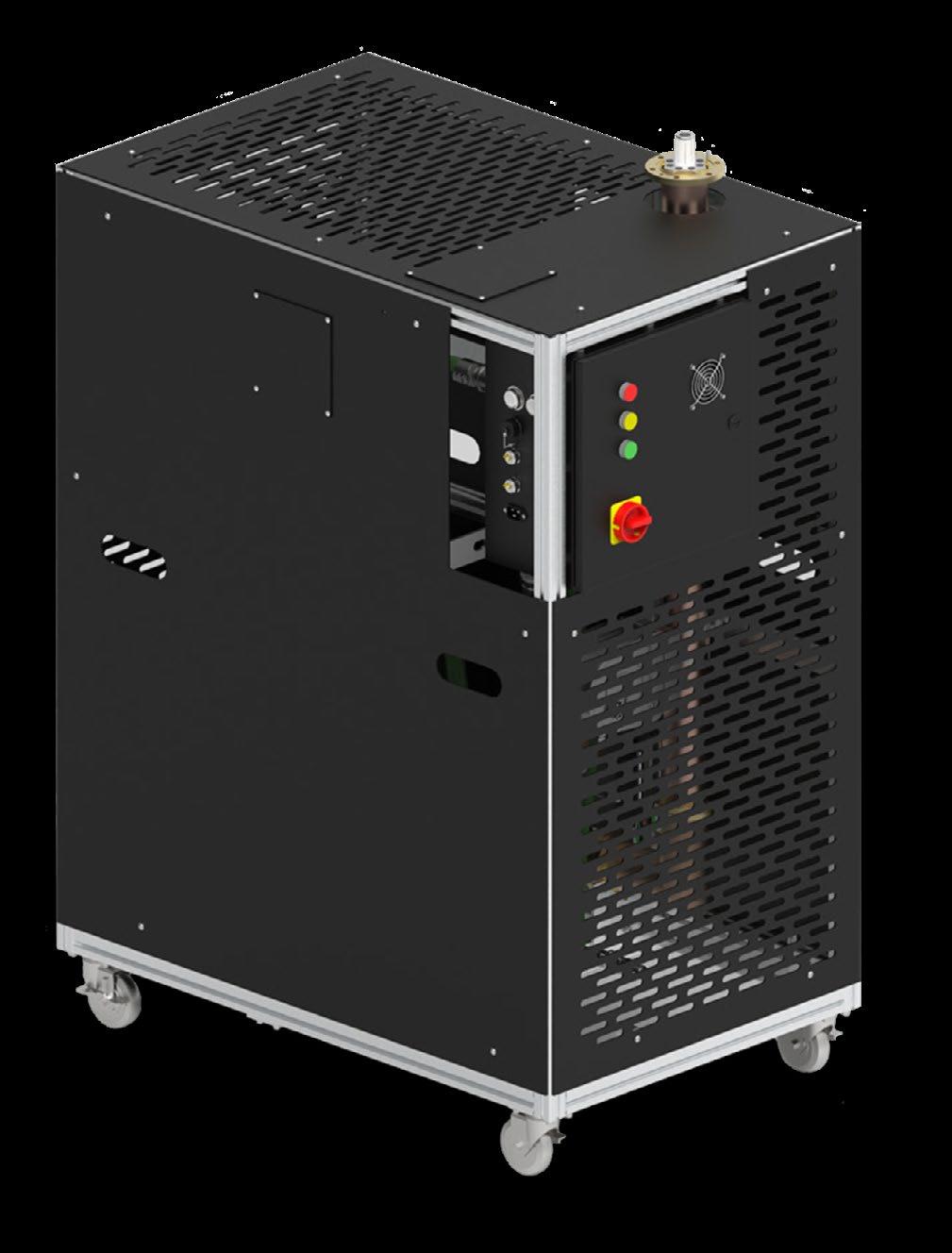
I was happy to see several low-cost set-top box devices displayed in the ATSC booth that support A3SA content protection. However, I’m still looking for an ATSC 3.0 NextGencompliant tuner I can plug into a USB port of my laptop to view ATSC 3.0 protected content on the road.
Dongles have been available for a few years, but none made it to the consumer market and none I’ve found support A3SA content protection. It doesn’t appear that will happen soon, but after seeing compliant set-top boxes based on Android TV, perhaps it will be possible to create an ATSC 3.0 dongle that will work with Widevine-enabled Android tablets. ATSC 3.0 has many advantages when it comes to mobility so I expect there would be demand for portable ATSC 3.0 receivers, especially in areas prone to hurricanes and other natural disasters. l
As always, your comments and questions are welcome. Email me at dlung@transmitter.com.
Television operations and production is a team effort where clear communication between all members is critical. Communicating a camera angle, inserting a graphic or counting into a video replay all require clear, uncluttered, undistorted communications between producers, directors, operators and technicians.
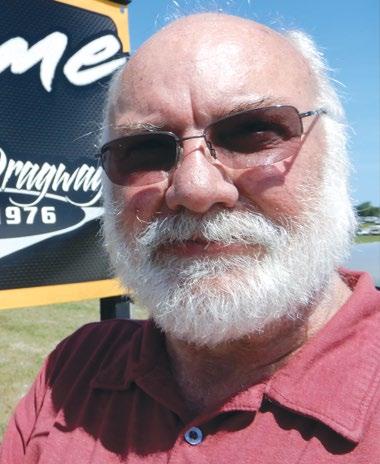
When I started working in television/outside broadcast, I used to think the most important job of audio was to get on-air and mix a good sounding show. I learned quickly that intercoms were probably the most important aspect of audio’s job. You can lose a camera, crash a record machine and even up-cut a commentary microphone, but if you lose the producer’s or director’s microphone you are probably screwed— believe me I know.
Television communications evolved from readily available telephone technology and even into the 1980s broadcast communication systems were a basic telephone “party line” configuration. The director’s camera conference would be where all the camera operators communicate on a single channel. Even a communications channel was often called a “P.L.,” which is shorthand for private line or party line.
In those days, the CBS OB van had only three basic channels of party-line communications— the director’s channel, the producer’s channel and an engineering channel. Additionally, there was the ever-present director and producer “hot mic,” which was heard throughout the OB van over open speakers so that if you were not on the director’s headset channel everyone could hear the director or producer over their hot microphone.
The 1980s began a period of improvements as the needs of broadcasters became defined and refined. Initial six-channel modular intercom systems were a lot like the analog days of telephones with delays and echoes that inhibited clear communications. Equipment manufacturers were quick to adopt the latest telecommunications
technology and next came various schemes of analog multiplexing where the systems evolved with increased channel counts along with programing flexibility. As with most things electronic, the final transition to digital solved most of the inherent deficiencies in an analog system.
I admit that there were some advantages to only having a few channels of communications, but the downside is that chaos can quickly ensue when someone gets “wound-up” and starts yelling over people on the same channel. Intercom etiquette not only includes polite interaction, but quick conversation.
My good friend and fellow mixer/A1 Pete Addams preached the concept of “word economization” when talking on the intercom systems. You don’t need a chapter’s worth of information when only a sentence or a word will do. The infamous producer Don Ohlymeyer only needed one
channel of communications and had the quietest communications of any live network production I witnessed. It was simple—the general rule was that everybody listened to Don and spoke only when spoken to. I miss Don!
Current communication systems have almost unlimited channels permitting abundant programing possibilities without worrying about limitations on channel capacity. Digital communications systems can easily be programmed for “party lines” or a “point-to-point” individualized channel. In addition to channel flexibility, digital intercoms have become incredibly sophisticated with programming that makes possible such things as splitting the left and right ears between different channels and being able to blend selectable channels together in each ear.
These communication tweaks are a tremendous benefit in a complex and hectic broadcast production world and personalized communications will endear you to most directors, producers and operators.

As necessary as intercoms are, there is a dark side to them. There seems to be a shield of anonymity when some people put on a headset. I remember being told by a three-lettered network that I had “thin skin.” The shield/excuse often was called “in the heat of the moment, or it was nothing personal.” Well, some of it I took personal and so did some of my colleagues. What has been excused as “locker-room talk” is not excusable over the headset.
As with most things electronic, the final transition to digital solved most of the inherent deficiencies in an analog system.
and a speaker and in the broadcast world there are many remote intercom stations that also have built-in speakers—and from my years of experience there was loose chatter that could be considered offensive, rude and down-right hateful. Before the HR and legal departments interceded, outside broadcasting had become wild and wooly, and the intercoms were the undoing of several on-camera talent and a few directors and producers.
Intercoms are often viewed as mundane and a necessary evil, but I contend that intercoms should be viewed as the backbone of a broadcast production and essential. A director will remember you if they had intercom problems before they would ever remember if you had a great mix! l
Remember, a headset is a microphone
Dennis Baxter has contributed to hundreds of live events including sound design for nine Olympic Games. He has earned multiple Emmy Awards and is the author of “A Practical Guide to Television Sound Engineering” and “Immersive Sound Production – A Practical Guide” on Focal Press. He can be reached at dbaxter@dennisbaxtersound.com.

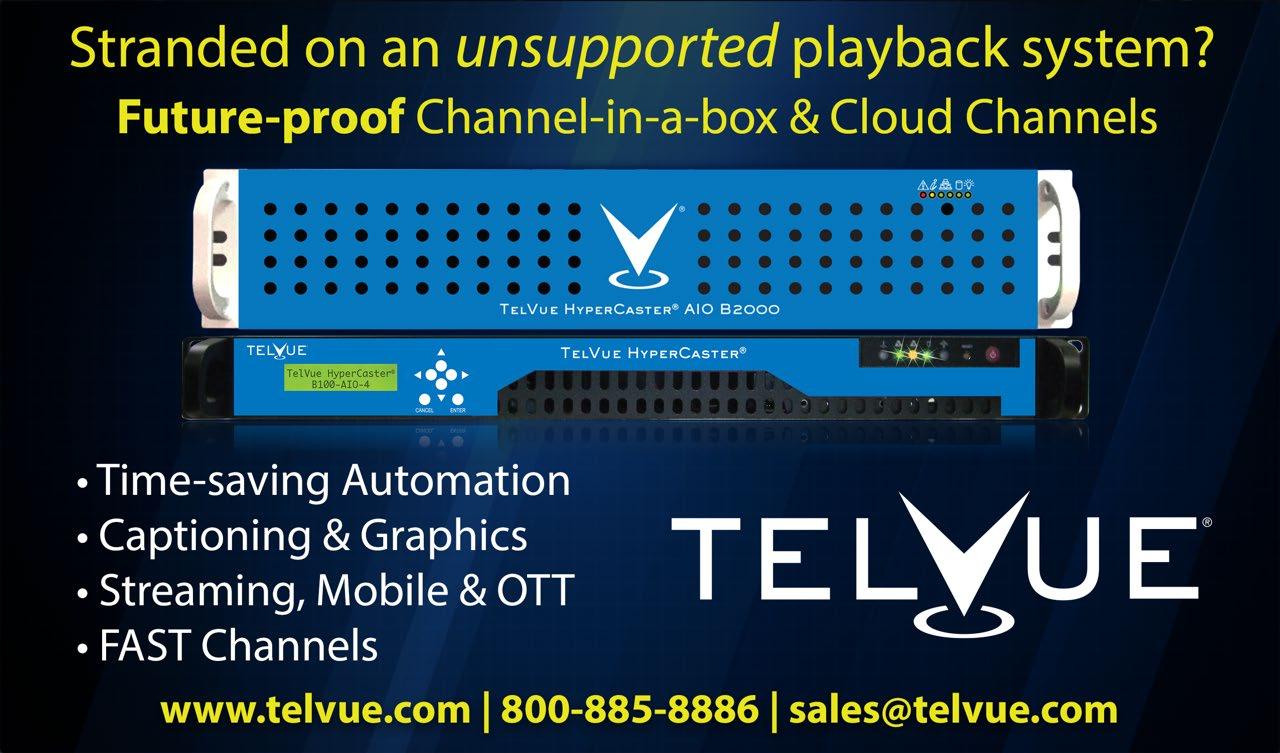

TV Tech recognizes innovation, excellence and creativity at the 2024 NAB Show with the Best of Show Awards. Congratulations to this year’s recipients!
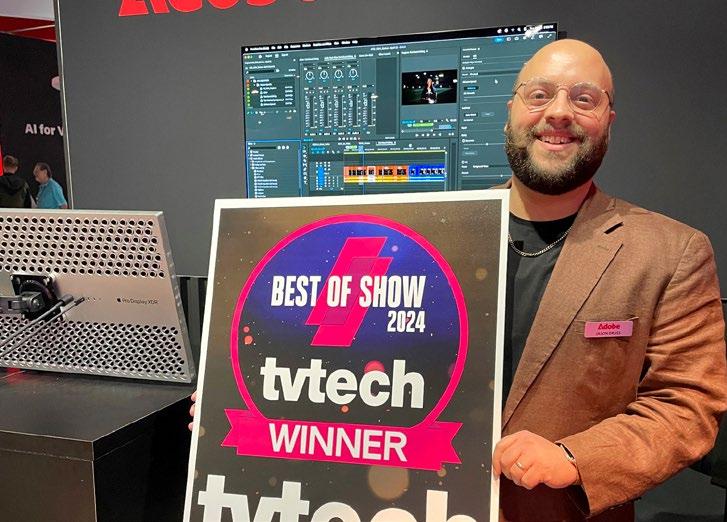
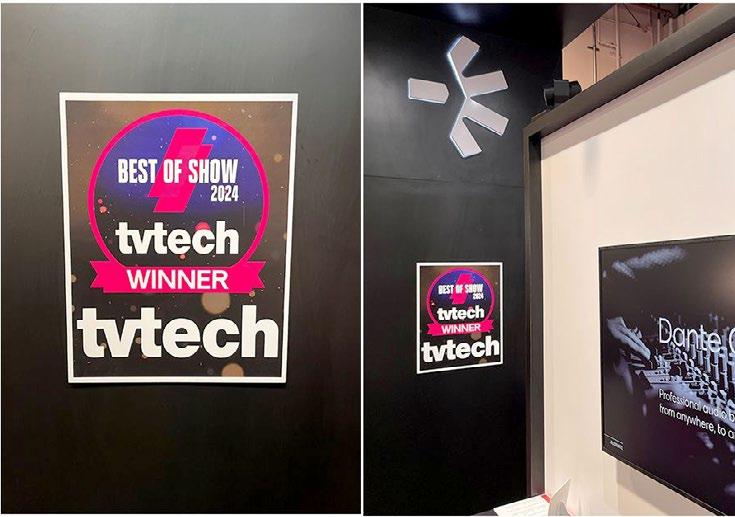





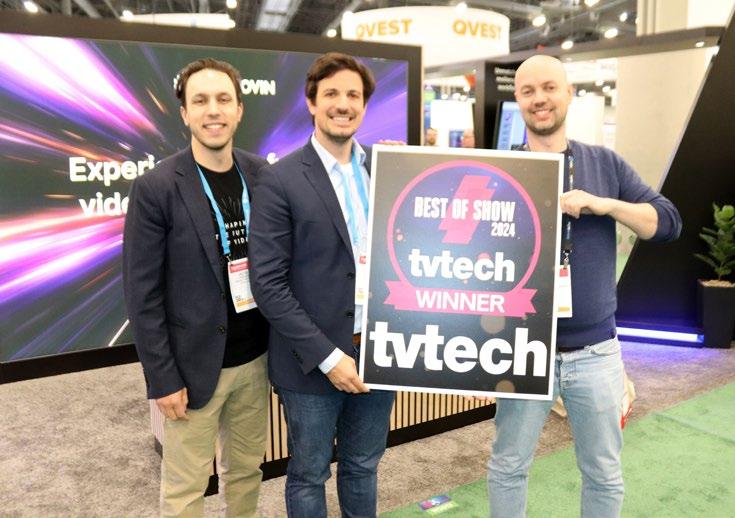





 Actus Digital - Actus MV–Interactive Intelligent Multiviewer
Ric Belding, Raphael Renous, Ken Rubin
Blackmagic DesignBlackmagic 2110 IP Converters
Shawn Carlson
Audinate - Dante Connect
Bitcentral - ViewNexa Channels Scott Nix
Apantac - HDR-UDX Thomas Tang
BirdDog - BirdDog X1. X1 Ultra
Black Box - Emerald AV WALL Stephanie Vanderbunt and John Hicks
AMD - AMD Alveo MA35D Advanced Media Accelerator Dave Peasco, Givish Malipeddi, Pavel Novotny
Adobe - Adobe Premiere Pro-Enhance Speech Jason Druss
Aveco - ASTRA Media Factory
Bitmovin - Bitmovin Analytics AI User Session Interpreter Peter Eder, Stefan Lederer, Jacob Arends
Boland Communications - BGM7-4K Gary Litwin and Mike Boland
Adder Technology - ADDERLink INFINITY 3000 Series Amelia De Grandis and John Halksworth
Actus Digital - Actus MV–Interactive Intelligent Multiviewer
Ric Belding, Raphael Renous, Ken Rubin
Blackmagic DesignBlackmagic 2110 IP Converters
Shawn Carlson
Audinate - Dante Connect
Bitcentral - ViewNexa Channels Scott Nix
Apantac - HDR-UDX Thomas Tang
BirdDog - BirdDog X1. X1 Ultra
Black Box - Emerald AV WALL Stephanie Vanderbunt and John Hicks
AMD - AMD Alveo MA35D Advanced Media Accelerator Dave Peasco, Givish Malipeddi, Pavel Novotny
Adobe - Adobe Premiere Pro-Enhance Speech Jason Druss
Aveco - ASTRA Media Factory
Bitmovin - Bitmovin Analytics AI User Session Interpreter Peter Eder, Stefan Lederer, Jacob Arends
Boland Communications - BGM7-4K Gary Litwin and Mike Boland
Adder Technology - ADDERLink INFINITY 3000 Series Amelia De Grandis and John Halksworth
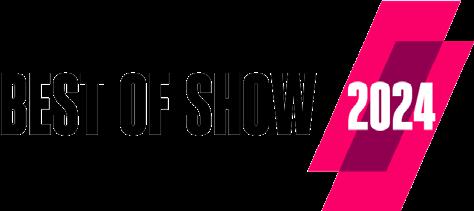





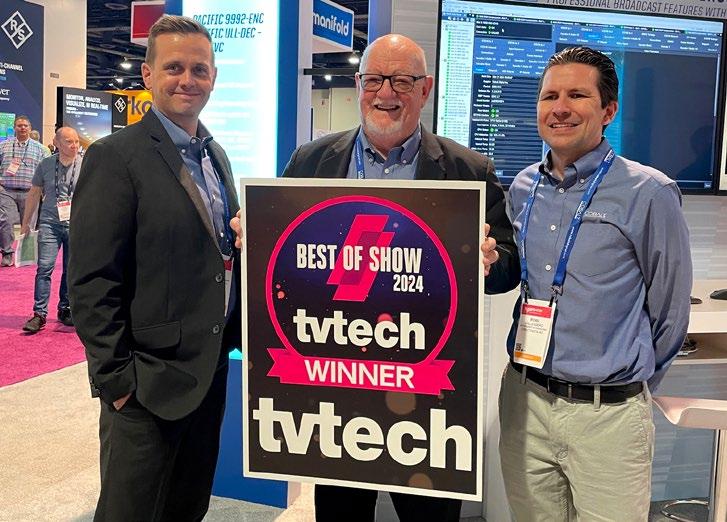




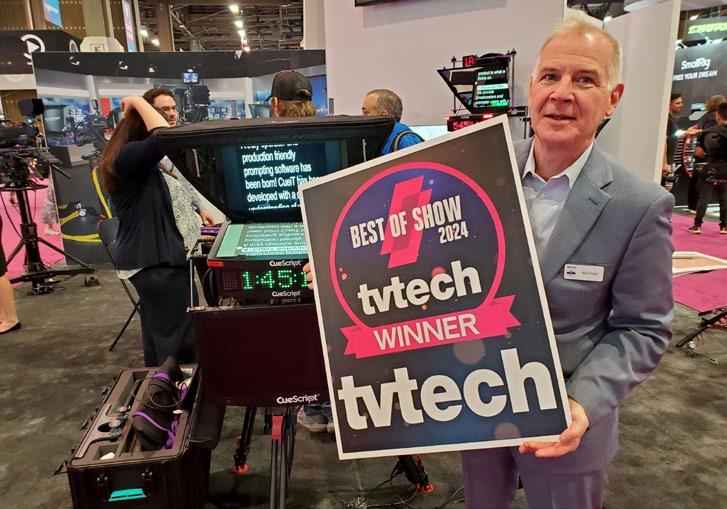
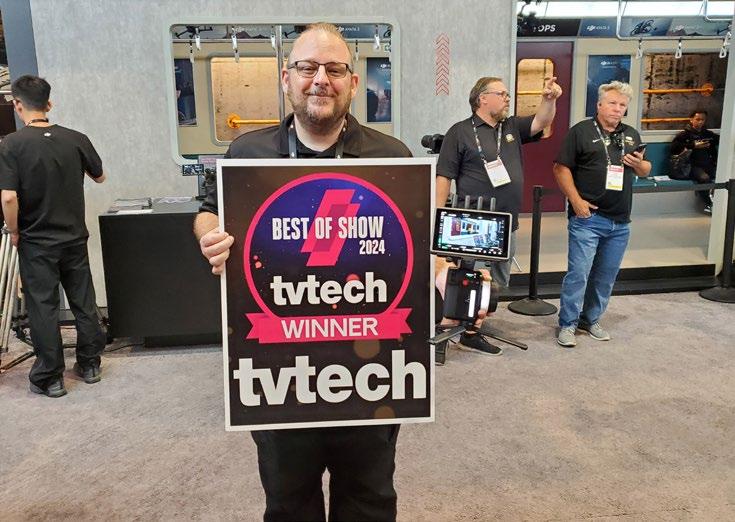


 Clear-Com - Gen-IC
Chris Wallis, Mitzi Dominguez, Marco Lopez
Eluvio - Eluvio Content Fabric and Application Suite-Casablanca Release
Clear-Com - Gen-IC
Chris Wallis, Mitzi Dominguez, Marco Lopez
Eluvio - Eluvio Content Fabric and Application Suite-Casablanca Release

E-Compact EC600HP-BB3 Series



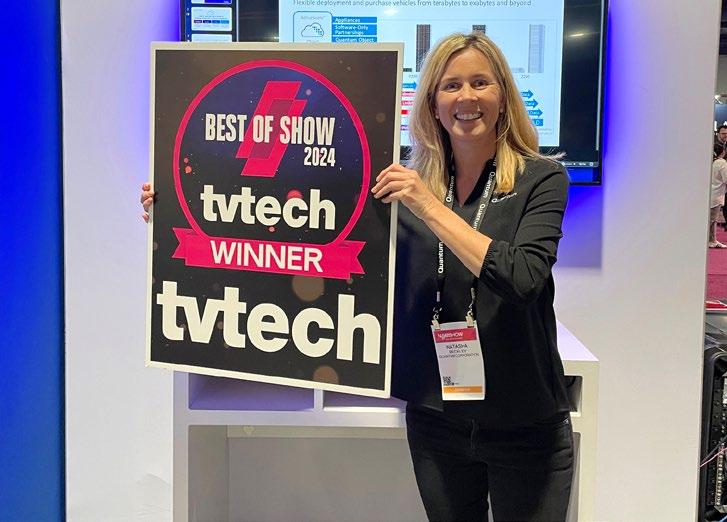


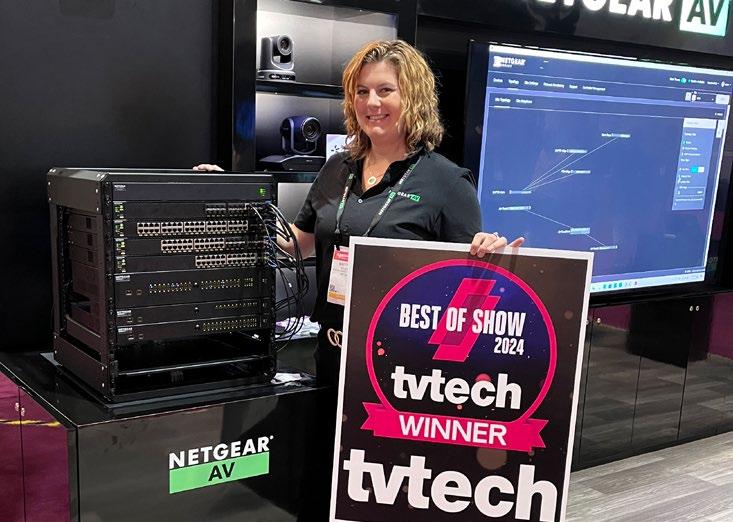


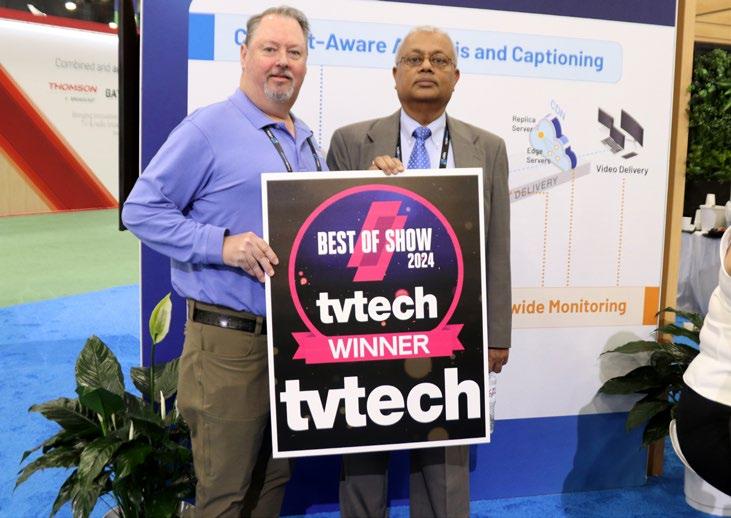

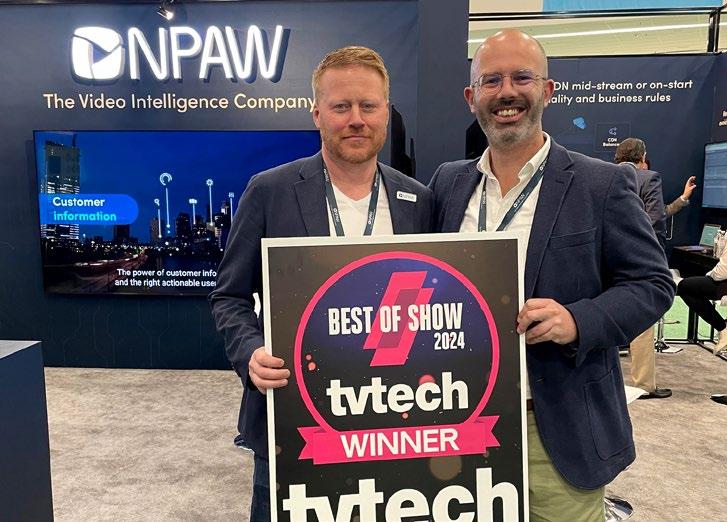
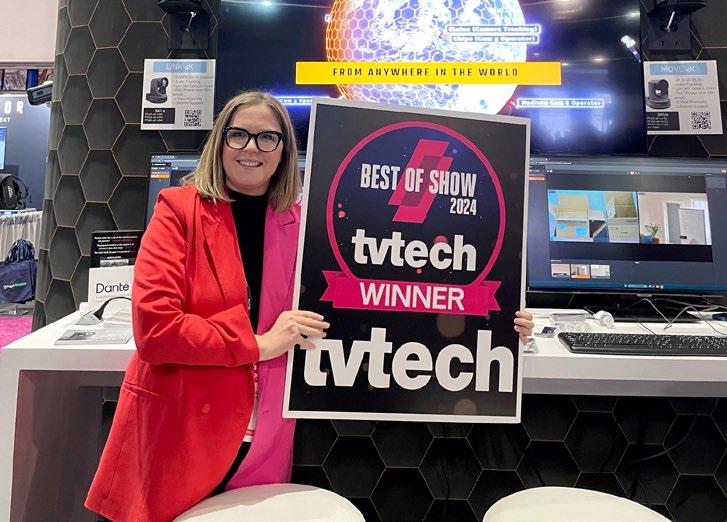
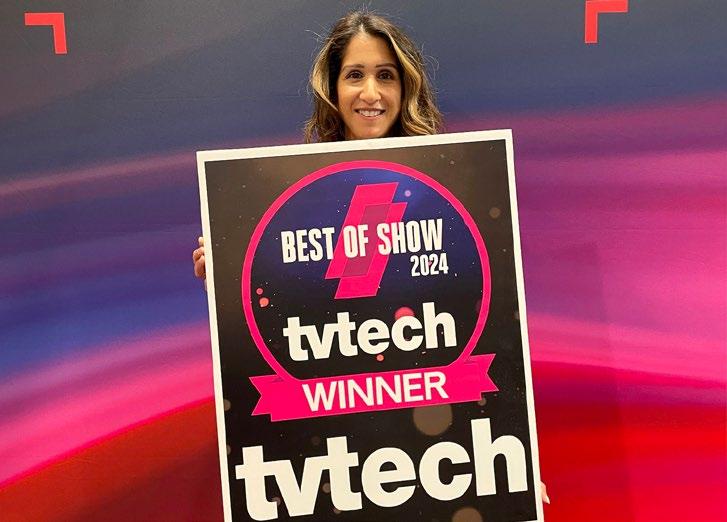 Hitachi Kokusai Electric Comark
Fabio Pina and Joe Turbowski
Interra Systems - BATON 9.0 Joe Johnson and Ashish Basu
LTN - LTN Arc Malik Khan, Colin Moran, Mike Burk
NPAW - CDN Balancer-Active Switching Till Sudworth and Rui Costa
PTZOptics - Hive Studio Tess Protesto
Quickplay
Quickplay Curator Assistant Tina Tuli
IMAX - StreamAware
Sabrina Macallister and Saj Jamal
Lawo - HOME management platform for IP Jeremy Courtney
NETGEAR AV - M4350 Managed Switches Brittany O’Leary
Perifery
The Perifery Intelligent Content Engine (ICE) Abhijit Dey, Seth Cohen, Dave Zabrowski
QuickLink - StudioPro
Rui Ribeiro, RIchard Rees, Bethany Hill, Brian Olson, Jordan Thomas
LucidLink - LucidLink
David Leopold, Gianna Sagan, Julie O’Grady, Mike Harp
Panasonic Connect North America KC200L1 KAIROS Core
Chris Merrill and Keith Vidger
Quantum - ActiveScale All-Flash Z200 Natash Beckley
Hitachi Kokusai Electric Comark
Fabio Pina and Joe Turbowski
Interra Systems - BATON 9.0 Joe Johnson and Ashish Basu
LTN - LTN Arc Malik Khan, Colin Moran, Mike Burk
NPAW - CDN Balancer-Active Switching Till Sudworth and Rui Costa
PTZOptics - Hive Studio Tess Protesto
Quickplay
Quickplay Curator Assistant Tina Tuli
IMAX - StreamAware
Sabrina Macallister and Saj Jamal
Lawo - HOME management platform for IP Jeremy Courtney
NETGEAR AV - M4350 Managed Switches Brittany O’Leary
Perifery
The Perifery Intelligent Content Engine (ICE) Abhijit Dey, Seth Cohen, Dave Zabrowski
QuickLink - StudioPro
Rui Ribeiro, RIchard Rees, Bethany Hill, Brian Olson, Jordan Thomas
LucidLink - LucidLink
David Leopold, Gianna Sagan, Julie O’Grady, Mike Harp
Panasonic Connect North America KC200L1 KAIROS Core
Chris Merrill and Keith Vidger
Quantum - ActiveScale All-Flash Z200 Natash Beckley


Rohde & Schwarz - TE1 Transmitter
Manfred Reitmeier, Thomas Janner, Olaf Fahrenkroog, Johannes Sinnhuber









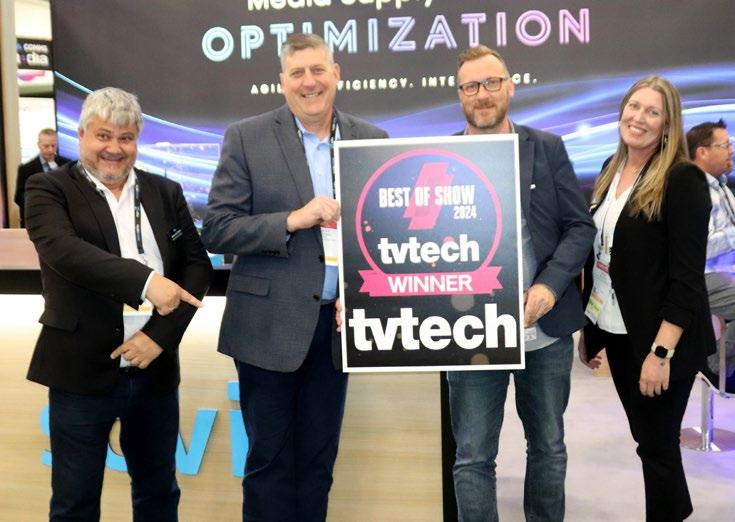


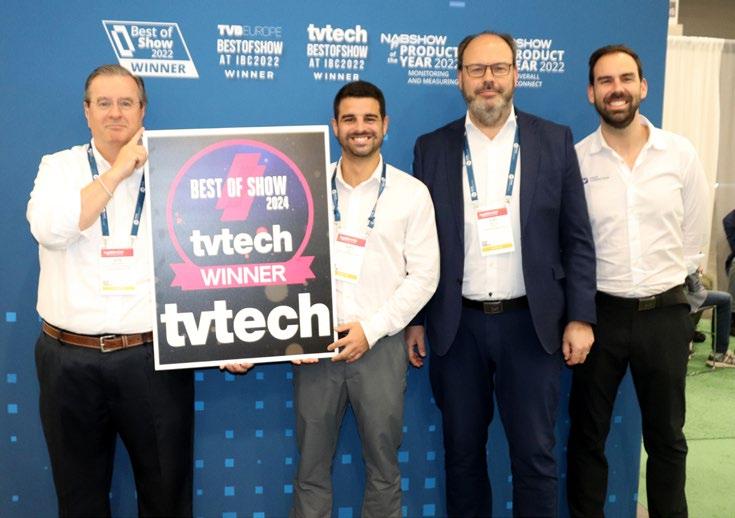
 Shure - Shure Axient Digital ADX3 Plug-On Transmitter with ShowLink
Sam Bicak
Ross Video - Artimo & TDx Series Panels Karen Walker and Shawn Snider
swXtch.io - cloudSwXtch Intelligent Media Network Cole Hermida and John Scanlon
Synamedia - MEG.mini
Elke Hungenaert, Julien Signes, Dean Kanelm, Mark Baillavoine
Witbe - Smart Navigate
Yann Caron, Marie-Veronique Lacaze, Mathieu Planche, Yoann Hinard
SDVI - Rally Access Workstation
Jose Luis Casas, Geoff Stedman, Simon Eldridge, Rose Sponder
VoiceInteraction - MMS
Ken Dillard, Joao Gil, Joao Neto, Joao Nuno Neto
Telos Alliance - Linear Acoustic AERO-series DTV Audio Processors Larry Schindel
Techtriq GmbH - qibb–the integration platform for media workflows
Jonas Michaelis, Roman Holzhause, Scott Goldman
Teradek - Prism Mobile 5G
Fernando Monetti and Martin Weber
Vubiquity - MetaVU
Armand Dicarlo, Schuyler Merrihew, Mihran Kazanchyan, Andre McMurray
Telestream - Stanza Jason Livingston
TVU Networks - TVU MediaHub Matt Keiler, Mikko Xu, Yoni Tayar, Rafael Castillo
Wheatstone - Strata Virtual Mixer
Shure - Shure Axient Digital ADX3 Plug-On Transmitter with ShowLink
Sam Bicak
Ross Video - Artimo & TDx Series Panels Karen Walker and Shawn Snider
swXtch.io - cloudSwXtch Intelligent Media Network Cole Hermida and John Scanlon
Synamedia - MEG.mini
Elke Hungenaert, Julien Signes, Dean Kanelm, Mark Baillavoine
Witbe - Smart Navigate
Yann Caron, Marie-Veronique Lacaze, Mathieu Planche, Yoann Hinard
SDVI - Rally Access Workstation
Jose Luis Casas, Geoff Stedman, Simon Eldridge, Rose Sponder
VoiceInteraction - MMS
Ken Dillard, Joao Gil, Joao Neto, Joao Nuno Neto
Telos Alliance - Linear Acoustic AERO-series DTV Audio Processors Larry Schindel
Techtriq GmbH - qibb–the integration platform for media workflows
Jonas Michaelis, Roman Holzhause, Scott Goldman
Teradek - Prism Mobile 5G
Fernando Monetti and Martin Weber
Vubiquity - MetaVU
Armand Dicarlo, Schuyler Merrihew, Mihran Kazanchyan, Andre McMurray
Telestream - Stanza Jason Livingston
TVU Networks - TVU MediaHub Matt Keiler, Mikko Xu, Yoni Tayar, Rafael Castillo
Wheatstone - Strata Virtual Mixer
DURHAM, N.H.—New Hampshire PBS currently operates three high-power DTV stations plus two LPTV translators across the state to serve Granite state viewers.
During the FCC repack, two of our high-power stations were affected; WEKW-TV in Keene (moved from Channel 52 to 18) and WLED-TV in Littleton (moved from Channel 49 to 23). For these two repack stations, we purchased new main and backup Parallax 5kW liquid-cooled transmitters from Hitachi-Comark. However, our primary station WENH-TV in Durham was not affected by the repack.
WENH signed on Channel 11 on July 6, 1959, making it the first educational television station in New Hampshire and one of the first educational stations in New England outside Boston. Our primary station serves the southeastern area of the state including the state’s largest city of Manchester and Concord, the state capital.
For the analog to digital transition, WENH was assigned Channel 57 during the simulcast period and analog channel 11 was shut off in February 2009. After the transition, we elected to go back to our pre-transition Channel 11; operating two Larcan air-cooled, solid-state DTV transmitters in main-standby mode. Note that these were actually the analog transmitters that we converted for digital operation. These two Larcan systems were originally installed back in 1996 so they were more than past their expected lifetime.
While looking for a replacement for these old VHF transmitters, we considered the reliability of the Parallax units that we had installed at WEKW and WLED. Both transmitter sites had main and backup DTV transmitters, and since the main transmitters operated so well, we we never had to switch to the backup.
We thought about converting and moving one of the backup units for use at WENH to replace one of the aging Larcans so we contacted Comark who were more than happy to work

with us on this unique project. Prior to the conversion, Comark made site visits to WENH and WLED to review the project and develop a cost-effective proposal to complete it.
In late 2022, we signed the contract with Hitachi-Comark. The backup transmitter from our WLED Littleton site was decommissioned; Comark then removed it along with the associated cooling pump system and heat exchanger. It was then returned to their facility in Southwick, Mass. where they converted it from UHF to VHF.
Since the transmitter is modular, the conversion primarily included replacing the internal three-way UHF PA RF combiner system with a new VHF three-way combiner. The rest of the Parallax transmitter was largely re-used. Hitachi-Comark also provided three new VHF liquid-cooled final amplifiers.
Once we converted to the 5 kW system, Comark delivered the new transmitter to our WENH-TV transmitter site. Before installing the new VHF system, Comark removed the
existing Larcan air-cooled system as well as the old, unused Harris UHF IOT DTV transmitter and associated RF mask filter. While this sounds like a simple process, the transmission equipment is located on the second floor of our facility with the only access via a hatchway in the floor and a chain hoist.
The newly upgraded Parallax VHF system was installed in place of the Larcan system, connected through the existing VHF RF mask filter system to help keep costs down. The cooling system was installed and the system turned on and the FCC proof-of-performance completed by Comark’s field engineer in March 2023. We’ve since noticed improvement in OTA signal quality.
We’re leaving the second Larcan system as a backup but will likely repeat this process with the backup Parallax system from WEKW in Keene and finally retire it altogether. l
Tom Nickodemus is a broadcast transmission engineer at New Hampshire PBS. He can be reached at tnickodemus@nhpbs.org. For more information visit https://comarktv.com.
The R&STE1 is an ATSC 3.0-native liquid-cooled transmitter that allows broadcasters to launch engaging, revenue-rich digital services while reducing operational costs, minimizing carbon footprint, and creating new business opportunities.

The R&STE1is at least 15% more energy efficient than the best current designs, and 40% more efficient than the average installed base, according to the company. The Rohde & Schwarz liquid-cooled transmitter technology ensures heat from the amplifiers is efficiently dissipated outside, eliminating the need for a/c. The design eliminates single points of failures, and the intelligent software control layer ensures that over the lifetime of the transmitter, the optimal efficiency is maintained throughout self-adaptation. All parameters can be monitored and controlled remotely.
www.rohde-schwarz.com/us
Vislink’s DragonFly V miniature HEVC wireless video transmitter seamlessly captures real-time, high-quality video from POV cameras, UAVs, bodyworns, concealments and static sports cameras. DragonFly V was designed with a minimized form factor and weight, combined with a low power consumption to reduce heat, and maximize battery-based operation time. The brand-new encoder accepts video formats up to 1080P 50/60 HDR, making it suitable for seamless inclusion into live broadcast workflows.
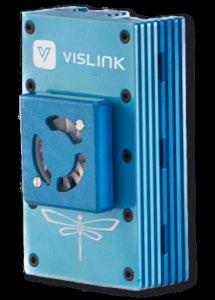
Equipped with a choice of HD/SDI or HDMI inputs, DragonFly V allows wide flexibility in miniature camera choices. Vislink’s miniature transmitter achieves a maximum COFDM output power of 50 mW, all contained within a package weighing less than 55 grams. This configuration ensures a reliable high-definition HDR video transmission in the smallest package available today.
www.vislink.com/
The EnGo 3x is a multicamera 5G mobile video transmitter and internet gateway in one. It leverages network aggregation technology to provide news and production teams with access to stable, reliable internet anywhere. Boasting multicamera support for up to four fully framesynced HD feeds, EnGo 3x reduces the cost and complexity of multicamera productions. It supports 4K UHD live feeds, making it easier for remote teams to monitor and detect lighting and color balance issues in real time. The wireless broadband internet connectivity offered by GateWay mode increases capacity for data-intensive applications such as newsroom systems or editing tools, and accelerates delivery of content from the set directly to post.
www.dejero.com
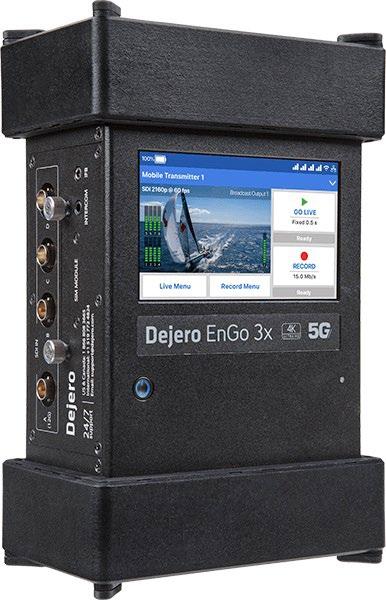

COLUMBUS, O hio—As the 33rd ranked DMA in the United States, the Columbus, Ohio market has a population of more than 2 million, with roughly 1 million TV households reachable via broadcast. WBNS-TV, the CBS affiliate serving the market, is now firmly in the sightlines of all these households thanks to the recent installation of a new GatesAir Maxiva UHF transmitter.
WBNS had been broadcasting through a Harris Sigma Diamond Drive tube transmitter since 1998 and was showing its age after 25 years. There were the expected component failures, and while repairable, the dwindling availability of parts became an issue. We finally decided to replace it two years ago when the tube manufacturer announced it would cease making tubes for the transmitter.
With a TPO of 58.3 kW, a liquid-cooled system is the only viable option, and we quickly set our sights on a new GatesAir ULXTE solid-state transmitter. The benefits were immediately recognized across the board, including a much smaller footprint, simplified maintenance, and noticeable improvements in performance.
Naturally, transitioning from a tube system to modern solid-state technology required a complete refresh of the infrastructure. The previous RF plumbing and liquid-cooling system were removed along the three-cabinet Sigma, making room for a far more efficient operation.
The ULXTE was placed in the same secondfloor space of a multi-tenant facility as the Sigma but occupying far less real estate. That allowed us to place the heat exchangers closer to the ULXTE, creating a shorter loop for the liquid flow as GatesAir suggests. Having more space means we now can move our GatesAir Flexiva FM radio transmitter into the same area.
The simplification of maintenance moving from tube to solid-state cannot be overstated.
Each ULXTE cabinet has its own pump, which means the transmitter now stays on the air with plenty of power if we need to take one cabinet offline. The previous system shared one pump rack across the three cabinets, which required taking the transmitter completely off the air for maintenance.
The ULXTE has a simple interior layout, with several power blocks that include PA modules, along with the phase and gain modules that feed them. Changing a module means removing two screws, sliding out the old and sliding in the new.
We otherwise keep an eye on the levels and conduct an occasional cleaning, which constitutes little more than a wipe-down. We monitor the liquid flow, which remains stable at 20 psi incoming and 40 psi outgoing. We regularly check power, temperatures and parameters that correlate with performance, including error vector magnitude (EVM) and shoulder attenuation.
Speaking of performance, the improvements are real. Our EVM has improved from 1.8 with the Sigma to 0.4 with the ULXTE, which results in a more
robust and vivid digital picture, especially so on the outer edges of the market. The built-in Maxiva XTE exciter consistently communicates a 10db improvement in sideband attenuation. It’s also more efficient, with a 100kW reduction in power usage.
The ULXTE also halved our air conditioning needs, allowing us to remove one of our two 10-ton units.
There is one more item of importance to note about the ULXTE: its ATSC 3.0 readiness, thanks in large part to the XTE exciter. With the appropriate RF infrastructure now in place, the exciter will be ready for ATSC 3.0 modulation with a simple firmware update. Once that update is made, we will begin feeding the exciter with a TSoIP feed instead of ASI and become a NextGen TV broadcaster. With GatesAir’s stellar service team on our side, we anticipate a smooth transition. l
Jason Knapp, supervisor of technology and operations for WBNS-TV, contributed to this article. Greg Armstrong can be reached at greg.armstrong@tegna.com.
For more information on GatesAir, contact Keith Adams at 513-459-3447 or visit www.gatesair.com
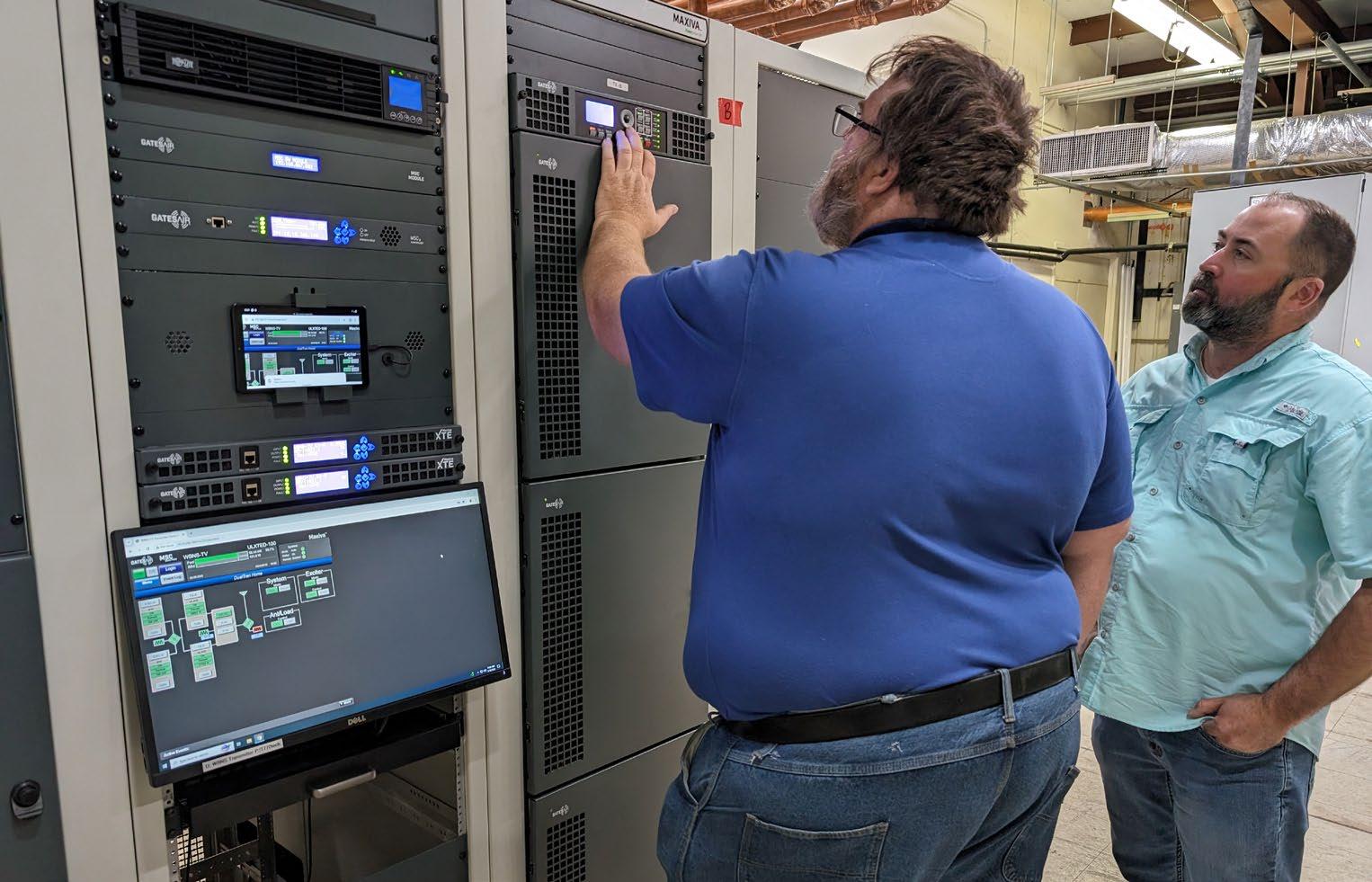
well as WHNO-TV in New Orleans as part of our ATSC 3.0 deployments.
By Hugh Allegood Director of Engineering Christian Television NetworkLARGO, F la —Christian Television Network (CTN) operates 24 television stations throughout the United States. As director of engineering, my responsibilities cover all areas of the technical infrastructure for each station, including all RF facilities and systems.
Preparing for an ATSC 3.0 future is one of our top initiatives group-wide and is keeping us very active on the RF side of the equation. We recently installed three new Dielectric antennas at WCLF-TV in Clearwater, and WFGC-TV in Palm Beach, both in Florida, as
Substantial power increases were approved for all three stations, with WCLF and WHNO (both UHF stations) increasing to 1MW ERP and WFGC, a VHF station, increasing to 65kW ERP. All three stations were also relocated to new tower sites, adding another layer of complexity to already challenging timelines. WFGC was relocated from UHF Channel 49 to VHF Channel 7 during the spectrum repack, and we added a new Dielectric VHF antenna on our previous tower once we landed on our new frequency. That antenna was optimized for horizontal polarization per our choice, but we later realized that a vertically polarized antenna would provide better coverage in the market.
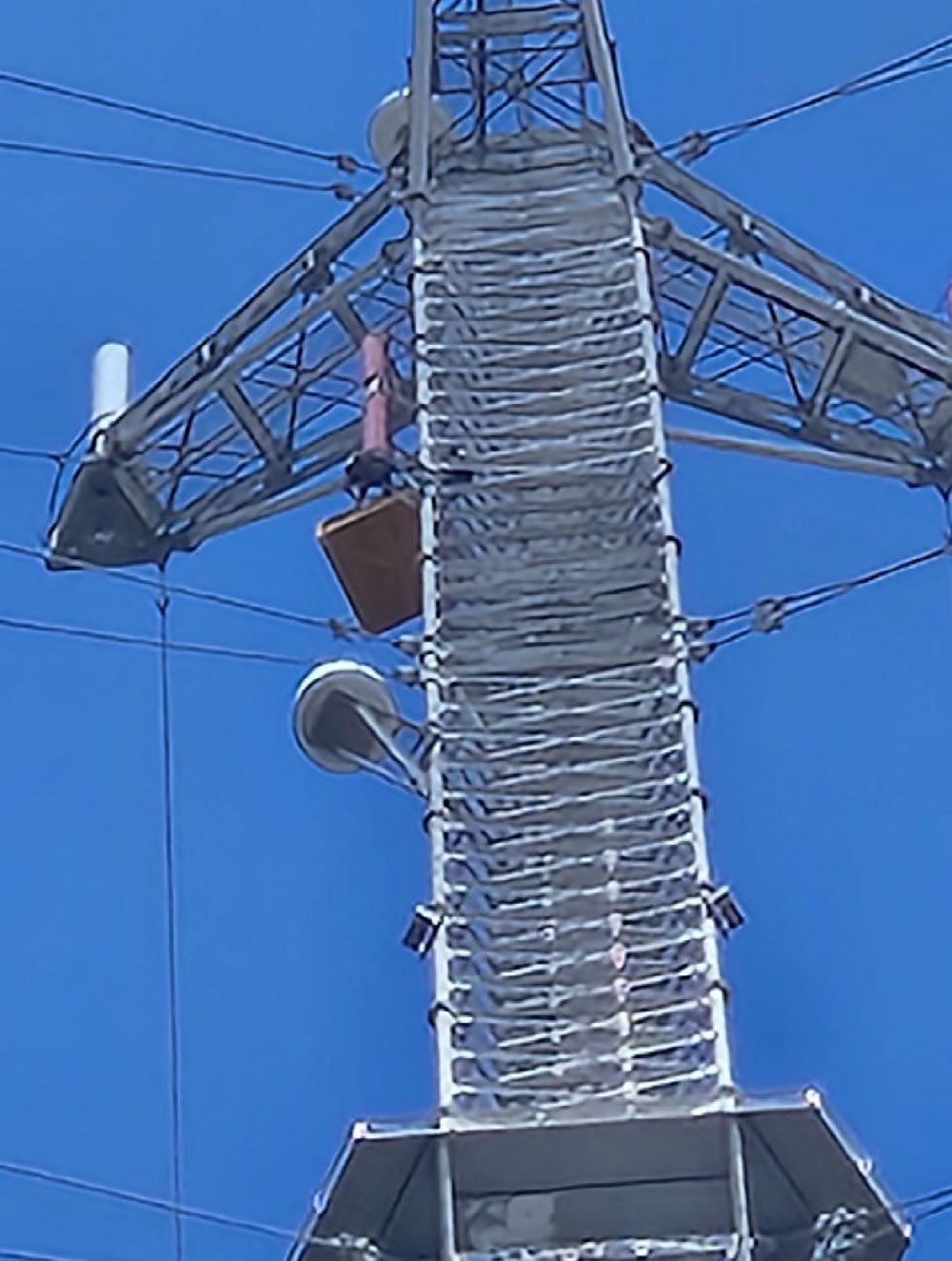

radiating over the Atlantic Ocean. The special azimuth null design includes specially designed fins that are mounted to the antenna, and these fins ultimately play an important role in shaping the direction of the signal.
We ordered a new Dielectric THV Series antenna that was well-timed with our tower relocation. This time we made sure to add a V-Pol element to improve our ATSC 3.0 coverage. Our expanded coverage area also benefits from a much higher tower position, moving from 450 feet to 1150 feet.
The difference has been enormous, and we are now maximizing our market coverage from Vero Beach south through into Miami, while also seeing major improvements in building penetration.
Our THV Series antenna is a simple five-layer antenna design that radiates with a peanut-shaped azimuth pattern in alignment with our coverage requirements. Dielectric added a null to the back of the antenna to protect the signal from
WCLF-TV, which covers the Tampa Bay market on UHF Channel 21, has enjoyed the biggest coverage increase since installing our new TFU-26EST-R C220 antenna in late 2023, nearly doubling our ERP. This allows us to reach viewers northeast of Tampa and out toward the Orlando region—areas we couldn’t reach with our previous ERP.
We exclusively use Dielectric antennas across our network, and, as anticipated, the performance of our three new sticks are rocksolid. I swept all the systems at the time they went to air and followed with a second sweep at each site 90 days later. The results were identical, with no discernable difference in performance and no challenges with reflected power.
Our relocation to new tower sites essentially required a complete refresh of the RF infrastructure for each station, and we additionally sourced our filters, transmission line and other RF components where necessary. Dielectric’s ability to manufacture and deliver antennas and RF systems within tight deadlines assured that we had our new systems in time for our tower moves, and allowed us to meet our goal of having all systems up and running by the end of 2023.
Hugh Allegood oversees engineering for all CTN stations as director of engineering and RF systems engineer. He can be reached at HughA@ctnonline.com. For more information on Dielectric, visit www.dielectric.com.
Electronics Research has introduced a new high-power UHF television antenna, the Cascade Series, available in top and side-mounted models and designed to optimize coverage for mounting location and configuration.
Cascade are unpressurized and fully radome-enclosed to provide stable performance under all environmental conditions. The natural shedding properties of the UV-protected-, abrasion-, and flame-resistant poly-
carbonate enclosure help to minimize icing and protect the antenna’s working elements, ensuring a long, useful product life.
The Cascade series includes models with horizontal, elliptical, or circular polarization. A vertically polarized component can enhance coverage and improve reception as more viewers opt to cut the cord and rely on overthe-air reception. www.eriinc.com


The LU800 PRO 4 is a portable multicamera solution designed for every type of production that offers flexible business models that offer significant cost savings. With the LU800, users can send up to four fully frame-synced feeds in high resolutions (1080p50/60, 10-bit HDR) from a single unit to any remote production center, physical or cloud-based. Providing multicamera capabilities on demand, users can activate the PRO2 for two cameras or PRO4 for four cameras whenever they need to produce a multicamera event. Ideal for on-premise productions, such as football matches, the LU800 provides multi-angle coverage of the game with close interaction with the players for an enhanced fan experience. The unit also ensures the highest reliability and resiliency, leveraging up to 14 connections (cellular, LAN and Wi-Fi) with up to eight 4G/5G internal dual SIM modems supported by high efficiency internal antennas. www.liveu.tv


For possible inclusion, send information to tvtech@futurenet.com with People News in the subject line.
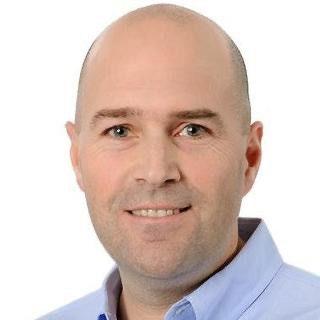
Amagi has appointed Richard Perkett chief product officer (CPO). With 25 years of experience in product management, product marketing, engineering and user experience, he will steer the company’s product strategy, focusing on aligning its SaaS portfolio with the goals and priorities of its customers. Perkett said he was inspired to lead “a talented product organization and contribute to shaping Amagi 2.0,” and to deliver even greater value to the company’s customers.

National Association of Broadcasters
Kirsten Donaldson has joined the National Association of Broadcasters as VP of public policy, to help to develop policy positions and formulate advocacy strategies for issues affecting the broadcast industry. Prior to that, Donaldson served as VP of Legal at the Digital Media Association (DiMA), where she represented global technology and streaming companies on copyright law and technology policy matters. Earlier she founded The Donaldson Law Group.

Pinewood Toronto Studios has appointed Sarah Farrell general manager of the studios, which incorporate 16 purpose-built sound stages including the 46,000 sq. ft. Mega Stage. Farrell joined the company as legal counsel in 2013, eventually overseeing legal, HR and client relations, before taking on her current role as general manager. Prior to joining Pinewood, Farrell spent her career working with some of Canada’s more influential media and entertainment companies.

C-SPAN
C-SPAN announced that CNN’s Sam Feist will be the network’s next CEO later this summer. He will be only the third CEO in the network’s 45-year history. Feist is currently SVP and Washington bureau chief of CNN’s DC bureau, which includes the network’s largest newsgathering operation. He also leads the digital and editorial transformation of CNN en Español, CNN’s Spanish-language network. Feist will remain at CNN through the end of June to assist with his transition there.
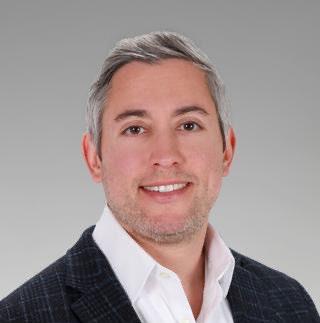
The E.W. Scripps Co.
The E.W. Scripps Co. has added Seth Walters to its sales leadership team as head of CTV sales. Walters, who is a media executive with more than a decade of streaming TV experience, will lead Scripps’ digital go-to-market strategy and help drive long-term CTV revenue growth across Scripps’ portfolio of brands including Scripps Sports, ION, Scripps News and local news. Most recently, he was the head of LG Channels in North America at LG Electronics, overseeing LG’s FAST service.

MEREDITH DELANEY Scripps Howard Fund
Meredith Delaney has been appointed president and CEO of the Scripps Howard Fund, the philanthropic arm of The E.W. Scripps Co. She previously served the Fund as director of philanthropic strategies and director of development. She has been with the fund since 2017. Delaney is a seasoned fundraising executive devoted to nonprofit work. Before coming to the fund, she served in senior development roles at the University of Cincinnati Foundation and United Way of Greater Cincinnati.

Television Academy Foundation
The Television Academy Foundation has appointed Anne Vasquez executive director. She will oversee operations and provide strategic leadership of its programs and fundraising. During her previous five years at EdSource, she established new partnerships, and expanded support by more than $2 million. Prior to EdSource, she served as SVP of strategic initiatives and chief digital officer at Tribune Publishing, where she led digital strategy across 10 news markets.

TSL
Gary Heelas has joined TSL as principal engineer in the company’s U.S. office. With more than 30 years of experience in electronics design, Heelas joins TSL after working for Evertz and PerkinElmer. At Evertz, he introduced high-definition video technologies to the company’s product line. At PerkinElmer, he was responsible for the electronics and firmware teams, focusing on development of infrared and ultraviolet spectrometers and thermal analysis instruments.

